#and the angels on their own are their flag identities as well as representing them
Explore tagged Tumblr posts
Text

I keep getting messages from people saying they wish they could get certain Pride Angels designs but don't feel comfortable doing so if it's not their flag. Personally this has never been an issue for me and I get any design regardless of flag if it looks cool. But I'm wondering if I'm in the minority here! Let me know in the poll.
#pride angels#poll#no right or wrong answer here just curiosity#it does make me a little sad to think people are missing out on things they want#but I understand if they are more particular about the flags they rep than I am#I feel like it's like a straight person wearing rainbow in solidarity#and the angels on their own are their flag identities as well as representing them#so you can also think of it like you are adopting and caring for a little gay angel creature#as opposed to getting a symbol that represents *you*#if that make sense LOL#it's easy for me to say that since they're my OCs#they are all my creatures to care for#also...if it feels forbidden to wear a design if it's not your flag#should it also be forbidden for a creator not of that identity#to make merch for it? Or maybe that's different
104 notes
·
View notes
Note
The comparisons between Zira and Stead confuse me but the comparisons between Crowley and Ed are even more confusing. They both share a darker aesthetic in fashion yes but that’s about it.

Thank you, Anons. I was so hoping that folks had read my post about OFMD, and I’m glad people have (as well as this post, which is where the tag you are referencing is from).
I do definitely feel a sense of confusion around the comparisons between Aziraphale/Stede and Crowley/Ed. I have thought about it more since writing that first post, and I feel that I again need to emphasize how much I enjoy both Good Omens and Our Flag Means Death, but that to me, they are completely different shows and characters and therefore shouldn’t be compared because they deserve to stand on their own.


The entire conceit of Crowley, in my opinion, is that he is not beholden to the standards and gender roles that humanity has created. He is a supernatural entity, and while he has plenty of other things that he is dealing with (such as the pain of Falling and not being “good enough” to stay in Heaven), the human part is what he has fun with, and is why he can play with gender so readily and embrace that androgynous beauty that we all know and love.
Ed, however, is completely beholden to those gender roles and is shown performing traditional “masculinity” throughout the show. He wants to be more like Stede and tries to dress like him and learn the niceties of aristocratic table manners, but he is still operating within those specific standards. In some ways, I feel like Crowley is what Ed wishes he could be, but for all his pirate-y badass outlaw ways, Ed still has that urge and need to conform.
In contrast, Crowley never wants to be like Aziraphale. He doesn’t want to fit in with the angels (and would probably miracle a Whoopee cushion onto Gabriel’s chair every single time he goes to sit down). Nor does Crowley long for “finer things,” but instead wants Aziraphale to be himself, to see how wonderful he actually is, and that he doesn’t need Heaven or any of it because they are on their Own Side.
It’s two different characters who, while on similar journeys of self-discovery and identity, take very disparate paths on those journeys. And the relationships that both of them are in or starting to be in (Crowley with Aziraphale, Ed with Stede) have an influence on those journeys, but again, in very different ways. Crowley has known Aziraphale for thousands and thousands of years and it’s a relationship of familiarity and having been through so much together and slow, steady growing attraction and love that has developed and deepened over time. Ed and Stede have only just met, so theirs is a relationship of newness, of seeming intense initial infatuation that strongly has the potential to grow into more, but hasn’t gotten there just yet.
Another moment that comes to mind when I think of the differences between Crowley and Ed and their relationships is the moment in OFMD where Stede and Ed share clothes paralleled with the moment in GO where Aziraphale and Crowley switch bodies. Of course, Stede and Ed dressing up as each other was fun and it was cute and silly, but to me, it represented them still only knowing each other on the surface. Aziraphale and Crowley, however, have (literally) been inside each other’s skin. The amount of trust Aziraphale places in Crowley and vice-versa is only something that can happen when you’ve known someone for a long time. It’s deeply intimate and personal, like letting someone see your innermost soul, or your underwear drawer.
So, yes. Two different moments that reflect two different characters and two very different--not better or less--relationships. Again, I know there are some similarities on the surface, and my goal in writing this was not to deny those, but to highlight how, when you look more closely, Crowley and Blackbeard do become quite different, and they deserve to be recognized for the unique, wonderful characters that they are.
I hope this all has made sense. Thanks for writing in, Anons! x
#anonymous#reply post#good omens#crowley#our flag means death#ofmd#blackbeard#edward teach#aziraphale#ineffable husbands#stede bonnet#blackbonnet#i actually probably could've written more because there is so much to unpack#but oh well#cinematic parallels#thoughts#discourse
18 notes
·
View notes
Text
Resistance to Violence
I just saw this video, and I found it very intriguing and impactful, intellectually. It actually did get me thinking differently about the main issue therein. https://youtu.be/YJSehRlU34w
When this video was published, I was probably already quite convinced of the virtue of non-violent resistance.
In recent years, however, I have seen more and more of how non-violent protesters have not only been subjected to oppressive violence in retaliation, but have also been publicly blamed for the violence being done to and around them, so that the corrupt media has successfully managed to redirect the sympathy that ought to be conferred on those who are bravely and peacefully standing in the face of violence and oppression, and twist it into even more support for the oppressive system. I have seen how violent regimes are perfectly willing to brutalize peaceful people just to assert and demonstrate their dominance, and then I see them getting praise from large swaths of the population who support that oppression.
On the other hand, I have also been thinking more about situations where violence was the catalyst to finally make progress for equality and justice. The Confederate States of America, the Nazis of Germany, and the various unconscionable horrors they wrought were not stopped by people protesting peacefully, by seeking common ground, by seeking to understand them better and make them comfortable. They were stopped by a sufficient opposing army slaughtering them until they ceased to be willing and able to pose a continuing threat to humanity.
It's also helpful, I think to contrast the end of the Confederacy with the end of the Nazis. Starting with the Confederacy: While slavery and white supremacy were certainly overtly stated goals of the Confederacy's rebellion, the Union was (and still is) hardly an anti-racist country, and it has been noted that their goal in fighting the Confederacy was more about retaining the Union than about ending slavery. In the end, when the Confederacy surrendered, there was an attempt by the victors to ease the feelings of the erstwhile rebels, to allow them to retain a great deal of "Southern pride". For that, we get the Daughters of the Confederacy whitewashing and rewriting history, the Ku Klux Klan continuing to wage terror across the country, and many of the various monuments and other dedications to honor Confederate leaders. The meaning of these symbols is clearly white supremacy, and not merely "Southern pride", as evidenced by how they're used. Many of these monuments were erected in the former Confederacy as part of the backlash against the civil rights movement in the 20th century, and some people even outside of America proudly wave the Confederacy's navy jack flag. Why would non-Americans wave that flag? Because they want to wave a flag for white supremacy, and they can't legally wave the flag of the Nazis.
The Nazis, by contrast, were obliterated. They were not allowed to retain "Nazi pride" after the fall of their heinous regime. The symbols of their monstrosity were banned. A standard of basic human decency was granted greater priority than the "freedom" of terrible people to do horrible things. Nazism was destroyed, not simply because it opposed other powers that wanted to control them, but because they were evil, and they needed to be stopped for the good of the world. The result is that now, less than 8 decades after the fall of the Nazis, Germany is a far more decent, pro-social democracy than the former Confederate states, which continue to stand for right-wing oppression, even over 15 decades after the surrender of the Confederacy.
Another example, though less of a dramatic one, is that of the Stonewall riot. The LGBTQ community did not start gaining rights and freedom from a horrifically oppressive regime because they were kind, nice, and peaceful, gently appealing to the better angels of their murderers and oppressors, making the effort to try to understand them and to meet them in the middle. What kicked off their victories at this time was Black trans women of color throwing bricks at police.
Considering all that, I found Chenoweth's presentation difficult to reconcile. When the oppressive regime has control over the media, when they make every peaceful protester look like a violent, dangerous terrorist, and they convince large portions of the population to be willing to fight for fascism, convincing them that it is actually "freedom", and that efforts for justice are actually an attack on their very identity, how can one possibly proceed? When those in power do murder peaceful protesters, do you keep showing up to protest peacefully? If you see someone going around shooting people left and right, do you stand there and demand verbally that the shooter stop?
So, what to do? We live in a violent society that has normalized routine violence against the poor, minorities, people of color, and all of the most marginalized and vulnerable in society. We only need 3.5% of the population to actively resist? Already 5.8% of the American population is in deep poverty, with 9.2% in poverty, generally. Globally, these numbers are even more horrifying, with 9.2% in deep poverty and nearly 17% in a state of being "multidimensionally poor", and nearly half living on less than the equivalent of US$5.50 per day. Couldn't we count on those people, at the very least, to oppose their own oppression? No, we cannot, partly because part of being so oppressed is being kept so weak and powerless that you don't have the energy to resist and being provided just enough that you're terrified to lose what little you have by daring to stand up, but also because so many of them have been brainwashed and corrupted into voting against their own interests and being willing to fight against the people who are trying to help them, and blame the even more marginalized among them or phantoms of foreign powers for all of their problems. Maybe if they knew what was really going on, we would have won long before now.
Now, regarding the topic of the video, the success of non-violent resistance, I very much appreciate that Chenoweth's presentation relied on statistical data from studies of hundreds of events rather than the mere anecdotes that were foremost in my mind when I started watching, and I also appreciate that she started by talking about the mindset from which she started, which closely resembled my own, including good examples of violent revolutions that ended corrupt regimes. I don't know exactly how the data she used to reach her conclusion were gathered and classified, and I retain some skepticism, but I would very much like to believe that her data are, in fact, representative, accurate, and actionable. I would very much like to believe that we can, in fact, win freedom and justice through peaceful means, though I have a hard time really being confident in it. I want to believe that she's right because otherwise, I see very little hope at all. We are very close to a point at which total environmental collapse is inevitable, with the majority of global power still putting the pedal to the metal to drive us off that cliff as fast as possible. The most aggressive policy proposals to save the planet involve easing up on the gas slightly, far too little far too late, and even those are being defeated by the regressive death cult of neoliberals, conservatives, and fascists. At this point, it is hard to see how any future can exist that does not involve tremendous destruction. Either the forces of evil win outright and destroy everything, or the forces that oppose them are forced to wreak so much destruction in order to stop them that they might as well have lost anyway. It's hard to imagine sometimes that we have not already completely lost, that the world is not already completely doomed, and all that is left is to watch as the monsters responsible for it just keep making things worse until the very end.
I guess the answer is just to have faith and to do whatever we can to give humanity the best possible chance, and that means two main strategic goals: 1. Motivate and influence enough people to reach that 3.5% threshold to actually resist for the change that we all need. 2. Determine an actual action plan for those people to carry out that will have the desired effect with a minimum of collateral damage and harmful side effects.
Sadly, I have no idea how to do either of those things, and anything I can think of still feels either depressingly small and insufficient or worrying for its potential to cause unintended harm.
5 notes
·
View notes
Text

As someone who plays games and enjoys stories that aren't terrible, I always love it when the setting of a tale is allowed to truly manifest. That is to say, when there's just as much attention put into it as there is for the characters, to the point where the setting might as well be its own character. It doesn't always have to be completely in-your-face mind you, but generally speaking, if you can feel the amount of personality given to the location, there's a nine out of ten chance that I'm going to appreciate it. Bonus points if it's really pretty.
Naturally, this extends to the world of Sonic. Though the level of backstory varies when not taking Japanese manuals into account, the many islands/planets/theme parks in space/parallel dimensions Sonic has visited over the years nonetheless tend to hold a lot of charm with the way their zones and stages are presented. And when it comes to Sonic in particular - when they're at their best - his style of environments have the perfect aesthetic for my personal tastes: full of whimiscal, cartoony character, yet beautiful and sincere at the same time (or ominous and sincere, in the case of Eggman's moodier fortresses and the like).
So it goes without saying that this has been one major focus of mine while writing for Sonic & Tails: Beyond the Stars, my own little fanfic adventure for the blue hedgehog. From the moment I started putting my story into words, I wanted to make an effort to give the land of Viridonia the same love and focus that was given to the likes of Angel Island and the Little Planet in the official installments. Granted, it helps that the nature of my story already relies on a considerable amount of presence for my setting, but that alone would be insufficient. We have to go deeper. We have to go... advanced.
Long story short, I spend far too much time imagining locations in my head for my oh-so-epic fanfic where a 90's caricature confronts his breakfast mascot arch-nemesis for the nth time. Seriously, do not underestimate me on this. I think about the colour schemes. I think about the architecture. I think about not only what type of music would fit each location, but also the specific mood to go along with it. “No guys, it would have THIS kind of icy music, not THAT kind of icy music.”
Hell, I even make crappy MSPaint flags that represent each of the zones, Unleashed-style, which are “proudly” displayed in the appropriate chapters. I'm on a drug, and that drug is making Sonic settings come to life despite existing purely in written form. Please help me.
So I figured I might as well expand a bit on some details that may interest those of you who read my fic, that couldn't be acknowledged too much in the fic itself without severely ruining the pacing of the story in the process. Note that you will NOT miss anything important in the fic proper if you skip on these posts. It's just a fun bit of behind-the-scene elaboration on the thought and inspiration involved, if you're into that sort of thing. Nothing more, nothing less.
Oh, and by the way? I hope you like Spyro the Dragon comparisons, because there's gonna be a lot of them as this series goes on, and I won’t be sorry for any of it. :] Yes, it's hardly surprising that my equal love for Spyro's environments (specifically Classic/Reignited Spyro, as I was never a Legend or Skylanders fan) plays a recurring influence in the way I visualize my Sonic zones, mainly with the way colour contrast is often used. That's not to say that the Sonicy aspects are lost or forgotten, though. After all, their universes are already pretty similar in terms of general aesthetic, so it's not too much of a stretch anyway IMO.
Anyhow, this intro has gone on long enough, so let's begin with the central hub of Viridonia, shall we? (I was originally gonna lump in Trudy’s castle and Gleaming Meadows in the one part, but each of them ended up being even longer than I expected, so uh, guess they’ll have to be separate.)
Creating the Hub: Lime Shores
Right off the bat, my goal with Lime Shores was very simple: to make it different from Station Square. No disrespect to Station Square, I love it as much as the next SA1 fan (especially its music!), but considering that a recurring motif of Beyond the Stars is to mirror certain aspects of SA1's story WITHOUT completely copying the whole routine, it was doubly important for the central town of Viridonia to have its own identity to help further that point. And since Lutrudis - and the rest of the folk on the island - are all inexplicably English to varying degrees and varying stereotypes, I knew what had to be done.
I’d make it look like Solihull, of course.
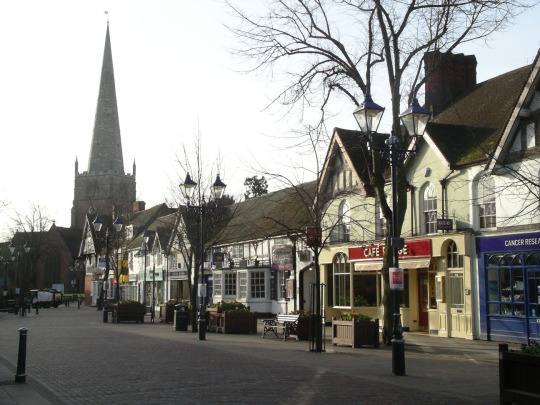
What? You thought it'd be based on London? HA. That comes later, in more Eggmanian territory. No, for Lime Shores, I wanted something a bit more gentle, something more quiet, something that looks rustic yet refined in equal measures... and something that contrasts greatly with the unique oddity that's been placed upon it.
Because let's not forget, as an everlasting side-effect of the Ethereal Zone's lingering power, much of the stony architecture has been given a nice gleam that causes it to change colour depending on the time of the day. Whereas in the daytime it looks suitably turquoise, the tones change to purple and pink by nighttime.
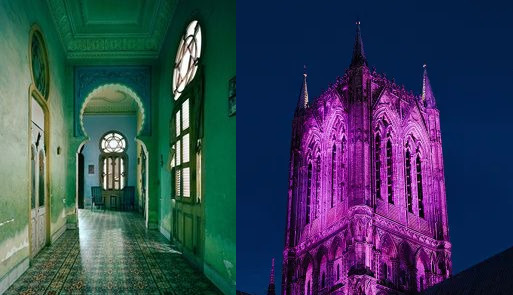
This might also explain why some occasional buildings look a bit... SEGA World-y...

It was important to make the town down-to-earth (for Sonic standards), because that way the Ethereal effects would be more striking. If it was a big proud metropolis like Station Square or Empire City, it wouldn't have the same impact. You'd still probably notice it, sure, but the contrast between the quaint vibe of the town with the increasing wonder if it was touched by aliens or some shit would be lost. (But don’t worry, a big proud metropolis is indeed featured in this story. You’ll get your Speed Highway fix in due time, though as expected, that too has an identity of its own...)
And of course, no area with Shore in the title is complete without, well, a shore. And sure enough, the waters near the shore are a slightly deeper sea green than average, even without the help of its nearby shiny rocks...

But what sort of music, pray tell, would accompany this unique town that kicks off Sonic's latest adventure? Well it may have a gentle disposition in spite of the Ethereal alterations, but it's still a Sonic adventure we're talking about, and Sonic is obviously going to be excited as hell to explore this new land with or without Eggman shenanigans in the mix. So to reflect his particular brand of upbeat passion, I think something along these lines will do nicely. (NOTE: I’ve decided to include two tracks for each location - some of them not even being Sonic-related - for the sake of more comparison and for driving the intended tone home all the more.)
youtube
youtube
But then, that's for the daytime. When it's night, however, we'll need something a little more relaxing and calm, yet still capturing a similarly mysterious atmosphere...
youtube
youtube
Also, there's a (completely optional) training simulator set up by Tails in Lime Shores. Should you ever try it out to brush up your skills in beating all those Eggman robots, the simulation would appear very reminiscent of the Colosseum from Sonic Battle, if it decided to trade in its green for blue. This is apparently the only noteworthy visual change in this piece of Miles Prower technology since 2004. Go figure.
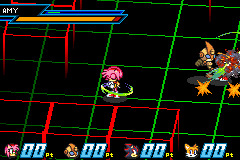
And finally, yes, the town comes with such charmingly English luxuries like a post office, a tavern, a museum, a spa, and... a Chao Garden.
Yes, they would all have different music tracks of their own.
No, I'm not going to list what I have in mind for each one. That would make this post longer - and sadder - than it already is.
18 notes
·
View notes
Text
15x06: Castiel
Is there anything more beautiful than turning points for a character? I don’t think there is. Cas has had a few of them throughout his journey (of course all of TFW have) but this episode he comes across a most likely enormous one, because this episode actually manifests his self-liberation in no uncertain terms, and given how far along we’ve gotten down the line with his progression, I’m thinking it’s most likely to stick.
It’s all about identity, right? Even this turning point that I’m so mysteriously hinting at. I’ll get to that.
Let’s take a look at the lay of the land this episode and it’ll bring us to why this turning point feels like it is shaking the very foundations of Cas’ core character traits and, hopefully, bringing about that needed change in the process.
Here’s the thing. When he was cast down from Heaven and turned human by Metatron stealing his grace, Cas was lost and was killed and then he was brought home to the Bunker only to be thrown out again, and so he named himself Steve and took a job at a Gas ‘n Sip because he couldn’t drape himself in the flag of Heaven anymore.
As a human, adrift and alone, he did the only thing he could think to do: he mimicked human everyday life. Not because he wanted to, but because he had to. He could see no other choice.
Until he called Dean to tell him about a case in the town where he’d settled (using settled loosely here since Cas was basically squatting at that same Gas ‘n Sip because he didn’t have a home of his own btw) and Dean showed up and reminded Cas what is at his core: to help. And that this desire to help is there even if he’s scared of dying, because that is what gives him a sense of purpose. (which is why he threw himself into that human everyday life to begin with: in search of purpose)
After Dean drove off in 9x06, telling Cas to live his life, Cas made a decision, for himself, to get back into hunting. To insert himself back into TFW, whether Dean wanted him there or not.
This was an enormous turning point for him, because for the first time he truly considered what he wanted for himself, and he went after it without hesitation.
Which was then promptly followed by Cas seeing no other choice but to swallow Theo’s grace and get his powers back, readying himself for the war that most surely was heading their way, because how could he be of service, of help, to the brothers and to the world without his powers?
Right? Right.
Now then, in 15x06 we get Cas in a deep state of identity confusion.
This is most clearly given to us through the name he chooses for himself.
Firstly, Clarence is a beautiful callback to Meg and perhaps that’s all it’s meant to be, but it’s also tying in with those early days that lay the foundation for the identity confusion Cas is still grappling with. So it’s interesting to me that he’d use it now, when he should be moving on, know what I mean?
And yeah, that brings us to the second Clarence, which is a character name from True Romance where the character Clarence Worley is played by Christian Slater and Worley is a posturing, bi-coded renegade of a male and has a lot of Dean in him (and I’m headcanoning that Dean has initiated Cas to the wonders of True Romance and done so fairly hardcore) so for Cas to actually, literally, name himself after a Dean-esque character is delightfully poignant.
Because it serves to underline how Cas is still not acting from a place that is based in having enough perspective on himself that he’s aware of what he wants, but rather we’re given to understand, in no uncertain terms, that he left the Bunker, pondered what to do and instead of considering what he’d do, he thought: What would Dean do?
And Dean, to relax and regroup and get away, would go fishing.
So, essentially, Cas is still in mimic mode.
Only this time he wasn’t told he had to leave the Bunker and what he deep down has always thought of as home and family and safety, even if he hasn’t felt like he truly belongs there: this time he chose to go.
And, this time, yes, he goes into mimic mode because he’s at a loss of what exactly he’s supposed to do now, but when a case presents itself, he doesn’t call Dean, he goes into hunter mode and leaves the mimicking behind, leaning on his own knowledge and understanding of what hunting down a monster entails, knowledge and understanding he’s accrued over his years of inadvertent training.
Granted he’s not human and he’s not risking his life the way he would’ve been back in S9 -- which was the reason (well, one of them, if you want to read the subtext as being that he genuinely wanted to see Dean and he hoped Dean would come look him up) he called Dean -- but he’s not fully fledged, his powers are failing him, and he doesn’t know what that means or what it will mean for him in the long run.
What is evident is that he doesn’t need his powers to do his job and do it well. He correctly identifies the monster as a djinn and locates what is evidently its lair without using anything but power of persuasion and research skills.
I could - over-zealous that I get at the mere prospect - read all this as meaning that we’re getting foreshadowing for how Cas doesn’t need his powers to live his life. Actually, it feels a little more like Cas’ powers are hampering his ability to live his life this episode, as the pastime that relaxes Dean Humanity Winchester does nothing to relax Cas-Still Angelic and thus Tied to Heaven-tiel. But the powers do save him, and they do allow him to do what is at his core: help. He heals Caleb, even though it takes a lot out of him
The taking a lot might be foreshadowing that his powers are diminishing to the point of soon not being there at all, or it might be an underlining of how we should root for him being powered up again, so that the moment he is will feel truly gratifying, because we’ve witnessed the struggle.
The gunshot wounds to his chest might be a highlighter for how he still sees himself as ‘thing’ and always expects to be able to heal himself, which could be a plant for how, if he becomes human, bullets flying at his head will carry a completely different meaning because he’s always been someone who absorbs such situations without even really blinking at them (like how he didn’t even flinch when Ketch blew up that car with the grenade launcher back in S12), or it could be another underlining of Powers=Good because they allow him to do what this entire episode pushes for him to do: stand up to authority.
And so we land in the-->
Turning Point
Which is Cas standing up to authority and, if you look at the subtextual implications, in so doing, breaking away from how he’s related himself to Dean for a whole lot of their joint arc, especially during the latter half of it.
This turning point is enormous for his individual arc: letting go of his proclivity for making choices based in servitude to the greater good (manifested in God and then in Dean) (his servitude always skewed since he should be making his choices based in his own sense of morality) (not trying to do what he thinks someone else wants him to do) and starting to make choices based in his own knowledge and understanding of himself and his place in the world.
And this newfound self-insight could potentially hopefully have an enormous impact on how he relates himself to Dean moving forward.
Because instead of this -->
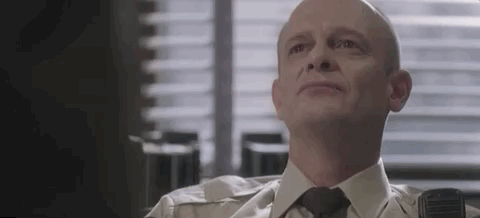

Leading to this -->
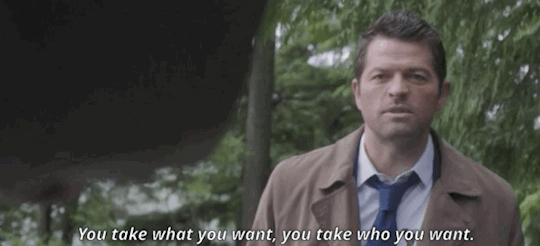
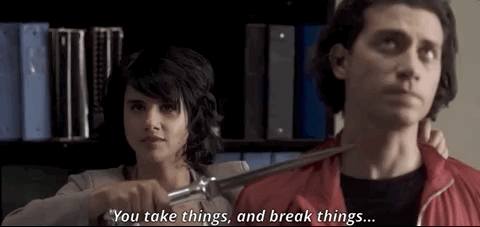
Ending in this -->
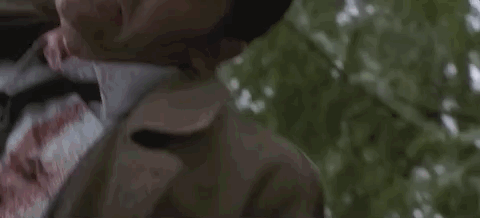

We’ll get Cas behaving based in this -->
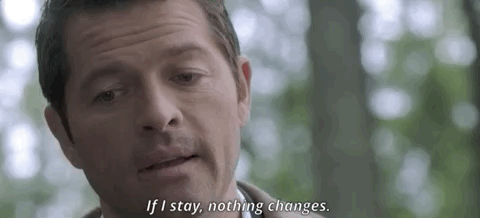
And the parallels here are rich as well, btw. They’re not as violent as they look, at least not the way I see it, because not only is the possible S8 callback (it’s what I got in my head anyway) a tie-back to a moment where Cas bowing to authority brought about emotional trauma, which led to him standing up to said authority, but on top of this, Dean as authority figure isn’t working anymore.
Dean as role model, Dean as compass, Dean as charge and the reason Cas uses for why he’s even on Earth isn’t holding up anymore. It hasn’t for a long time now. And in this moment Cas not only knows it, but I would say he accepts the truth of it.
The sheriff is a toxic masculinity representative in the most classic sense and it’s beautiful how Cas uses the lines that Miriam threw at Dean in 13x01, almost to underline the parallels here, but also to tell us how little Cas is ready to bow down to this type of power.
As such, it’s not just a parallel to Dean, but to Chuck as well, which is why the turning point is so layered and carries so much weight: this moment is Cas telling a representative of what God now is in the narrative (and granted always has been) this his sense of entitlement, that his belief that he deserves his position and that he should be worshipped simply because he’s in that position, won’t convince Cas to obey.
This then morphs from a moment of empowerment to a moment of loss of control as the soldier mode takes over, yeah? The djinn needed killing, but slaughtering?
There are a myriad of possible implications here, but the sentiment of the scene itself is Cas breaking free and stating unequivocally that he sees through fake points of authority and will not follow blindly anymore. Cas sees through the bullshit now. He’s breaking free of his indoctrination once and for all.
Which is why the episode, for Cas, ends in that absolutely mind-blowing decision to contact Sam, which we’ll be privy to in the next ep, because Cas realises that staying away won’t solve anything and it’s not the way he can actually truly help either.
He felt he had to cut communication in order to make a statement, but ignoring Sam is neither smart nor does it serve his intention of making Dean understand he’s in the wrong and that he should stop being such a selfish douche.
Staying in the game, but making certain that Dean acknowledges he’s been entirely unfair and apologises, is more mature than giving everyone the silent treatment and missing out on vital information pertaining to the probable end of the world in the process.
All of this has me excited for what it means for Dean and Cas, without me expecting that it means anything! Dean shows how he’s ready to let Cas go live his life as best he sees fit, but he’s going to call Cas out for being a dumbass, yeah? Which is well-deserved. Cas is being stupidly stubborn and he really should answer Sam. Dean is letting go (while, you know, being forlorn without Cas but recognising that this forlornness is his own burden to bear) and isn’t going to tell Cas to come back.
I mean, unless Cas shows he didn’t mean move on as in remove myself forever from your presence and stays in contact with Sam, because then there’s a chance that what Cas wants and needs... is an apology. *slow eyebrow raise*
What it looks like to me is them being placed in a position to choose one another without needing the other to define their identity, or even to assist in providing perspective. They are moving into facing that final fear - their shared fear of happiness - and through facing it, beginning to believe that they deserve to be happy.
I am just way too curious now to know exactly where it’s all landing! We know Dean will give in, we know he’ll end up reaching out, but omg what will that mean overall? I mean... will Cas hear that prayer, is my foremost question, with his powers dwindling? #wewillknowafterChristmas
#spn 15x06#spn meta#spn speculation#cas#darling cas#human!cas#what does the dwindling of his powers mean for him??#I'm dying to know!!#deancas#destiel#meredith glynn
93 notes
·
View notes
Text
The Dead Professor and the Vast Pro-India Disinformation Campaign
— By Abid Hussain & Shruti Menon | BBC Urdu & BBC Reality Check | December 10, 2020
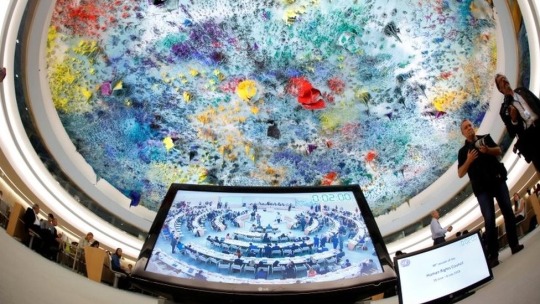
captionThe UN Human Rights Council meets at least three times a year and reviews UN member states' rights records
A dead professor and numerous defunct organisations were resurrected and used alongside at least 750 fake media outlets in a vast 15-year global disinformation campaign to serve Indian interests, a new investigation has revealed.
The man whose identity was stolen was regarded as one of the founding fathers of international human rights law, who died aged 92 in 2006.
"It is the largest network we have exposed," said Alexandre Alaphilippe, executive director of EU DisinfoLab, which undertook the investigation and published an extensive report on Wednesday.
The network was designed primarily to "discredit Pakistan internationally" and influence decision-making at the UN Human Rights Council (UNHRC) and European Parliament, EU DisinfoLab said.
EU DisinfoLab partially exposed the network last year but now says the operation is much larger and more resilient than it first suspected.
REVEALED: Indian Chronicles – how a massive 15-year influence operation successfully targeted the EU & UN with 750+ fake local media and 10+ zombie-NGOs. Executive Summary & full report: http://indianchronicles.eu Here are the facts 👇 (1/n) (EU DisinfoLab @disinfoEU)

There is no evidence the network is linked to India's government, but it relies heavily on amplifying content produced on fake media outlets with the help of Asian News International (ANI) - India's largest wire service and a key focus of the investigation.
The EU DisinfoLab researchers, who are based in Brussels, believe the network's purpose is to disseminate propaganda against India's neighbour and rival Pakistan. Both countries have long sought to control the narrative against the other.
Last year, the researchers uncovered 265 pro-Indian sites operating across 65 countries, and traced them back to a Delhi-based Indian holding company, the Srivastava Group (SG).
Wednesday's report, titled Indian Chronicles, reveals that the operation, run by SG, is spread over at least 116 countries and has targeted members of the European Parliament and the United Nations - raising questions about how much EU and UN staff knew about SG's activities, and whether they could have done more to counter those activities, especially after last year's report.
Mr Alaphilippe said the EU DisinfoLab researchers had never encountered such co-ordination between different stakeholders to spread disinformation.
"During the last 15 years, and even after being exposed last year, the fact that this network managed to operate so effectively shows the sophistication and the drive of the actors behind Indian Chronicles," he said.

Some of the many news sites the investigation found to be fake
"You need more than a few computers to plan and sustain such an action," he said.
The researchers cautioned against "definitively attributing Indian Chronicles to some specific actors such as Indian intelligence services" without further investigation.
Ben Nimmo, a disinformation network expert, told the BBC the uncovered network was "one of the most persistent and complex operations" he had seen, but he too was wary of attributing it to a specific actor.
Mr Nimmo, who is director of investigations at digital monitoring firm Graphika, cited previous examples of privately-run large-scale troll operations. "Just because they're big, it doesn't necessarily mean they're directly run by the state," he said.
The BBC approached the Indian government for comment but had received no response by the time of publication.
Of ghosts and defunct NGOs
One of the most important findings of the open-source investigation was establishing direct links between the Srivastava Group (SG) and at least 10 UN-accredited NGOs, along with several others, which were used to promote Indian interests and criticise Pakistan internationally.
"In Geneva, these think tanks and NGOs are in charge of lobbying, of organising demonstrations, speaking during press conferences and UN side-events, and they were often given the floor at the UN on behalf of the accredited organisations," the report says.
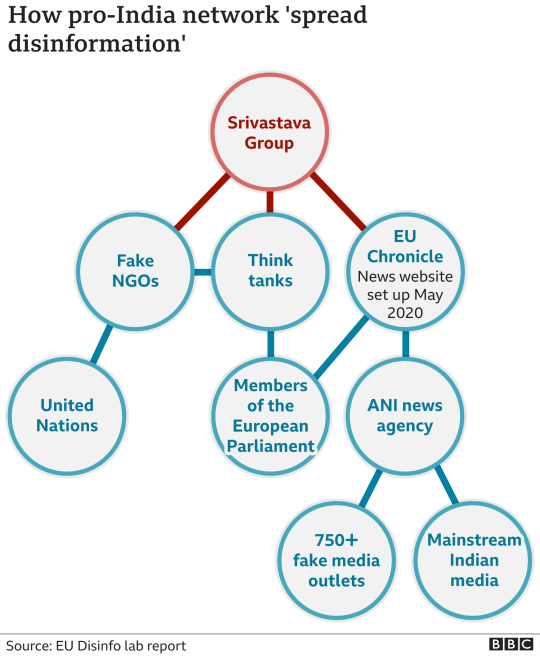
The investigation shows that the operation led by SG began in late 2005, a few months after the UNHRC was founded in its current form.
One particular NGO which caught the eye of the researchers was the Commission to Study the Organisation of Peace (CSOP). The CSOP was founded in the 1930s and won UN-accreditation in 1975 but became inactive later in the 1970s.
The investigation found that a former chairman of the CSOP - Prof Louis B Sohn, one of the 20th Century's leading international law scholars and a Harvard Law faculty member for 39 years - was listed under the name Louis Shon as a CSOP participant at the UNHRC session in 2007 and at a separate event in Washington DC in 2011.
The listings shocked the researchers because Prof Sohn died in 2006.
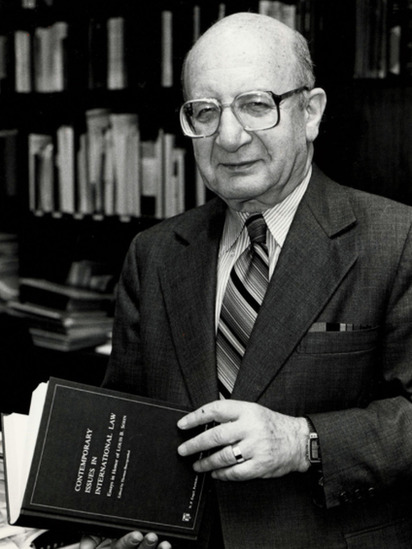
Louis B Sohn "appeared" at events years after he died
The authors dedicated their investigation to the professor's memory, writing that his name had been "usurped by the malicious actors in this report". They said CSOP "had been resurrected, and its identity hijacked in 2005 by the same actors depicted in our first investigation".
The investigation also shows there were several hundred pro-Indian interventions by the non-accredited NGOs, which were repeatedly given the floor at the UNHRC on behalf of the accredited organisations, pursuing the same agenda of maligning Pakistan.
On other occasions, NGOs and organisations which seemingly had nothing to do with Pakistan or India according to their stated objectives would get the opportunity to speak at the UNHRC and target Pakistan.
In March 2019, during the UNHRC's 40th session, United Schools International (USI), another UN-accredited organisation with direct links to SG, allowed its slot to be used by Yoana Barakova, a research analyst with an Amsterdam-based think-tank called the European Foundation for South Asian Studies (EFSAS).
Ms Barakova spoke about "atrocities committed by Pakistan" during the session. She told the BBC that EFSAS was a partner with USI and she was "not responsible for organisational logistics". The BBC received no reply when it contacted the director of EFSAS, who also represented USI at the same session to criticise Pakistan.
Vast pro-Indian 'propaganda' network exposed
Outrage over right-wing Euro-MPs' Kashmir visit
India buzzes with fake news of 'civil war' in Pakistan
Fake pro-China accounts exposed
The primary news agency re-packaging and boosting pro-India content related to SG appears to be ANI, established in 1971, which describes itself as "South Asia's leading multimedia news agency, with more than 100 bureaus in India, South Asia and across the globe". Indian news media, especially broadcast media, thrive on content provided by ANI.
EU DisinfoLab found at least 13 instances of ANI re-publishing mostly anti-Pakistan and sometimes anti-China op-eds by Members of the European Parliament (MEPs), originally published on EU Chronicle, one of the fake news sites linked to SG.
EU Chronicle was born in May this year when EP Today, a site flagged in the previous disinformation report, was simply discontinued and renamed.
The EU DisinfoLab report said: "The actors behind the operation hijacked the names of others, tried to impersonate regular media such as the EU Observer... used the letterhead of the European Parliament, registered websites under avatars with fake phone numbers, provided fake addresses to the United Nations, created publishing companies to print books of the think-tanks they owned.
"They used layers of fake media that would quote and republish one another. They used politicians who genuinely wanted to defend women or minority rights to ultimately serve geopolitical interests and gave a platform to far-right politicians when convergent objectives could be reached."
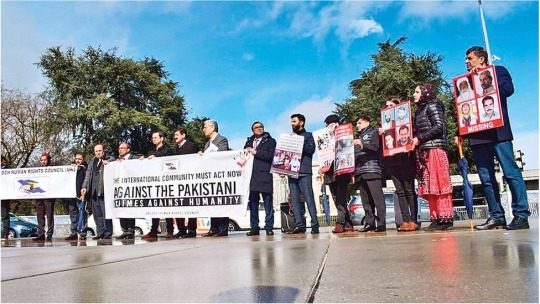
Protesters demonstrate against Pakistan outside the UNHRC in Geneva last year
Mr Alaphilippe said the news agency ANI was being used to give legitimacy to the entire "influence operation", which relied "more on ANI than on any other distribution channel" to give it "both credibility and a wide reach to its content".
ANI's news reports have found space in many mainstream Indian news outlets and publishers. Its content was further reproduced on more than 500 fake media websites across 95 countries, the researchers found.
Demonstrations in Europe conducted by organisations linked to the Srivastava Group have also been covered by ANI, as well as by fake media websites linked to SG.
Focus on the EU and UN
According to the findings of the investigation, the disinformation network had a two-pronged strategy to spread influence.
In Geneva, the think-tanks and NGOs were in charge of lobbying and protesting, and taking the floor at the UNHRC on behalf of accredited organisations.
In Brussels, the focus was on the MEPs, who were taken on international trips and solicited to write "exclusive" op-eds for fake outlets like EU Chronicle, which would then be amplified using ANI, the researchers found.
A group of MEPs appear regularly in the investigation. One of them, French MEP Thierry Mariani, has written two op-eds for EU Chronicle and was also part of a controversial visit to Indian-administered Kashmir last year.
"If the Indian government is behind the newspaper [EU Chronicle], it is not my problem," Mr Mariani, a member of France's far-right National Rally, told the BBC.
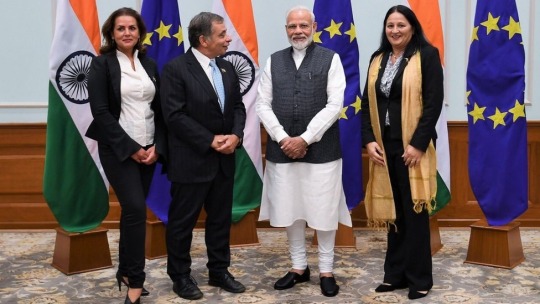
Organisers and delegation members met Indian PM Narendra Modi during the MEPs' controversial 2019 Kashmir trip
"I sign what I want and I feel, it is my opinion. I have connections in [India's governing] Bharatiya Janata Party (BJP) and I support the government of [Narendra] Modi," he said.
Two other MEPs named in the report - Angel Dzhambazki from Bulgaria and Grzegorz Tobiszowski from Poland - denied having written op-eds that were published on EU Chronicle.
The articles under their names were also reproduced on ANI.
How to spot a bot
The human cost of 'fake news'
Seven ways to stop bad information
Asked what the EU is doing to fight disinformation networks, EU spokesperson on foreign affairs Peter Stano pointed to the action taken to expose EP Today last year.
"Exposing the disinformation and those who spread it is one of our main instruments," he told the BBC. "We will continue to identify them and call them out."
But he said questions about finances and transparency of NGOs registered in Brussels were for Belgian authorities to answer.
Rolando Gomez, a spokesperson for the UNHRC, told the BBC that it was the prerogative of NGOs to raise whichever issue they wish to address and whoever they grant space to speak on the floor.
"There are no rules stating that an NGO must speak to specific issues. Doing so would amount to infringing on their freedom of speech," Mr Gomez said.
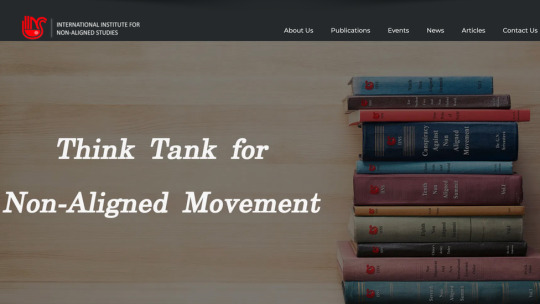
The International Institute of Non-aligned Studies is UN-accredited and openly linked with the Srivastava Group
Gary Machado, managing director of EU DisinfoLab, said he thought the muted reaction to the revelation of the disinformation network was partly because it was "clearly managed by Indian stakeholders".
"Imagine if the same operation was run by China or Russia. How do you think the world would have reacted? Probably with international outrage, leading to public inquiries and probably sanctions," he told the BBC.
But the activities of MEPs named in the report prompted criticism from some of their colleagues.
MEP Daniel Freund from the Greens said fellow members needed to declare their activities.
"There have been at least 24 breaches of rules in the past years. Not a single violation has been sanctioned. So there is little incentive to respect the rules when the worst that can happen is to file a declaration after you have been caught," he said.
Another member, who did not want to be named, said MEPs contributing to sites like EU Chronicles had been identified as "election tourists".
"A ragtag group of MEPs from the bottom of the parliamentary barrel who prefer to travel on sponsored trips by unsavoury governments rather than invest in their mandate," the MEP told the BBC. "How PR stunts with such individuals could be even conceived as helpful is baffling."
The BBC put questions to ANI and to nine other MEPs who have written op-eds for the EU Chronicle and made visits to India, Bangladesh and the Maldives, but received no response.
Who are the Srivastavas - and what next?
The investigations from last year and this year show a man called Ankit Srivastava at the centre of the entire global operation that was uncovered. More than 400 domain names have been bought through Mr Srivastava's private email address or through email addresses belonging to his organisations, the EU DisinfoLab investigations found.
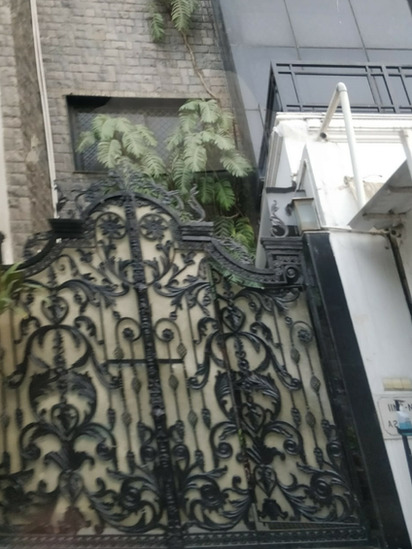
The Srivastava office gate, with the Indian Institute for Non-Aligned Studies and New Delhi Times on the right
Then, there's a case of the mysterious SG-owned tech firm Aglaya. Its website has been inaccessible since at least February this year but in the past the company has advertised products for "hacking/spy tools" and "information warfare services".
Aglaya's marketing brochure mentioned the ability to "hamper country level reputations" and described some of its services as "Cyber Nukes". In a 2017 interview with Forbes magazine, a man called Ankur Srivastava claimed he "only sold to Indian intelligence agencies".
It's unclear what relation, if any, he has to Ankit Srivastava.
A third Srivastava appears to be Dr Pramila Srivastava, chairperson of the group and mother of Ankit Srivastava.
Dr Harshindar Kaur, a paediatrician from the Indian state of Punjab, told the EU DisinfoLab researchers that in 2009 she had been invited to the UNHRC in Geneva to give a lecture on female foeticide when she was threatened by a woman called Dr P Srivastava, who claimed to be a "very senior government official from India".
Dr Kaur told the BBC it was Pramila Srivastava who had threatened her.
The BBC emailed Ankit Srivastava asking him to respond to this and the other allegations in the report, but received no reply. When the BBC visited the firm's offices in Delhi's Safdarjung Enclave, staff there would not answer questions.
What might happen to the network, or how it might evolve, in the light of the latest investigation is unclear.
The authors of Indian Chronicles say their findings "should serve as a call to action for decision-makers to put in place a relevant framework to sanction actors abusing international institutions".
Mr Alaphilippe said following the 2019 investigation there had been "no official communication, no sanction, nothing. This passivity gave a message to Indian Chronicles: you've been exposed, but no consequences".
"We think there should be consequences to disinformation and we expect actions to be taken. The biggest failure from institutions would be if another report is released next year on the same actors with the same techniques," he told the BBC.
"This would mean that EU institutions are ok with foreign interference."
2 notes
·
View notes
Text
A Brief Summary Theory of Allegory of DRIPPIN

This thread is under the cut :”) Let’s start~
Allegory of DRIPPIN is a prequel film based on the interviews with production team and entire members of DRIPPIN, about their experiences while preparing for their debut. Allegory based on the Greek’s word ‘allegoria’ means fables, metaphors and refers to a form in which abstract concepts are expressed using other specific objects rather than directly expressing them.

The Door [Cha Junho] Junho is dragging the door with seven boxes tied around his waist in a dark place of some old trees and a secret space. He put down the door he was holding in front of the six doors and take out a medallion with the sound of a clock ticking behind out from his arms and put it into a box of light leaking out. He delivers the box and give it to each person in a space behind the door. Junho who appears with a large door and opens another room door to hand over a box, is a glimpse of how he had to return to his trainee status, after disbandment of X1 in order to prepare for a new start.
significant object: the gold medallion (represents the prize he won during his participation in an audition program; the sound of a clock ticking when he brought out the medallion symbolizes the time that he spent with his previous group, X1 is short and precious for him. A medallion is often a realization of something important in the life. Sometimes it refers to a heritage from the past that is being realized now)

Inside a Box [Kim Dongyun] Dongyun sits on the sofa and holds a box of light leaking out. He sits in a darkened space with two huge stone statues . He tooks out a Pinocchio marionatte from his arms and put it in a box. Dongyun’s room expresses the loneliness he felt while waiting for other members to join as he is the first member to join the group. The large statue facing him also symbolizes Dongyun, who looks at the figures he yearns to be in the future, Dongyun’s Pinocchio marionette stimulates the imagination of what Dongyun “means”.
significant object: Pinocchio marionatte (represents the imagination of who is Kim Dongyun, he is a trainee that improving his skills by practicing harder and he’s slowly improved day by day that made him as one of the member of DRIPPIN, Dongyun finally achieved his dream to debut as an idol; Pinocchio one of the famous character of the children literature, despite being a wooden puppet, he is prone to mischief, laziness, greed, and foolishness, but he learns to be selfless by giving all his hard-earned money to the agent of the Fairy, who is reportedly quite ill. Pinocchio finally achieves his dream of becoming a real boy.)

Inside a Box [Kim Minseo] Minseo sits on the sofa and holds a box of light leaking out. He sits in a huge space surrounded by a lot of chairs. He tooks out a telescope out from his arms and looking out through before he put it in a box. Minseo’s room expressed the moment he felt when he made a fatal mistake on an audition program he starred in immediately after joining Woollim Ent. as trainee. At that time, he feels as if the time had stopped, and his stinging eyes were expressed as empty seats as if they were frozen. In addition, the Red tree behind Minseo symbolizes his inherent dreams, passion and aspirations to rise.
significant object: telescope (represents how Minseo feels when he made a fatal mistake in an audition program. He was looking out through a telescope that symbolizes he is not strong by heart and will break when faced with trouble. A telescope also represents that they need to become strong by heart and a metaphor that points out something they need to unveil or make clear)

Inside a Box [Lee Hyeop] Hyeop sits on the sofa and holds a box of light leaking out. He sits in a space full of endless repetitive steps and paper airplanes. He tooks out a broken wing plaster statue from his arms and put it in a box. Hyeop’s darkened room represents memories of his past practice alone and failing to quench his musical thirst. In addition, the endless repetition of stairs and paper airplanes expresses Hyeop’s desire to climb high places with full talent.
significant object: broken wing plaster statue (represents how Hyeop past experiences before he accepted as a trainee in an entertainment. He dreamed to become and idol but he don’t have a company. An angel with one wing still in tact symbolizes freedom and that no matter what happens, there is still hope. Then, Hyeop accepted as a trainee in an entertainment and able to make his debut. Hyeop able to ‘picking up his broken wing’s and learning to fly again.

Inside a Box [Alex] Alex sits on the sofa and holds a box of light leaking out. He sits in a darkened space with red, yellow and black colors. He tooks out a crystal ball out and put it in a box. The combination of red, yellow and black colors in the dark space symbolizes the color of Alex’s national flag, Germany. He sitting on the stairs means Alex’s effort and challenges, which had come up high to become a DRIPPIN member, although he was frustrated and tired because he couldn’t communicate well in Korean. The Solar System Crystal Ball that he brought out expressed concern about the different views he has on himself.
significant object: Solar System Crystal Ball (represents the different views and thoughts that Alex has on himself)

Inside a Box [Joo Changuk] Changuk sits on the sofa and holds a box of light leaking out. He sits in a muddy brown space which has a rough surface. He tooks out a masquerade mask out and put it in a box. The masquerade mask symbolizes Changuk’s past when he was a trainee that refused to reveal his innermost thoughts even though he was struggling. The rough surface of the space represents Changuk’s frustration with the situation where he wanted to do better than anyone else, but it didn’t go well on his way.
significant object: masquerade mask (represents how Changuk refused to reveal his innermost thoughts even though he was struggling; masquerade mask is used to hide someone identity/ their real feeling)

Inside a Box [Hwang Yunseong] Yunseong sits on the sofa and holds a box of light leaking out. He sits in the middle of a colorful field. He tooks out a question mark model and put it in a box. The wreck seen in Yunseong’s room captures his pressure and anxiety to lead the team as the leader of DRIPPIN. The question mark model symbolize there is something that he need to question whether it is about his past or future.
significant object: question mark model (represents there is something that he need to question whether it is about his past or future. Question mark states old age and insight and wisdom about how he is open to new things and he need to move forward with some decision or action)

DRIPPIN’s Door [All Members] All seven members of DRIPPIN standing together while holding their box of light respectively in the dark forest. Then, Junho opened the door he brought with and all the remaining members running with him entering the new place that symbolizes they will start a new journey of their life and the clock in the space represents the things that they want will soon to happen and they will acheved their dream. The box of light they previous brought together from their past/dark side are smashed to the ground represent all doubts/things that they worried during their training period are all gone and they are ready for a new beginning.
big thanks to main translated source: © drippin global : [1] // [2] // [3] // [4] // [5] // [6] // [7] or you can read the theory that i’ve found on twitter here (seriously op’s theory is so detailed and well understood thumbs up 👍) *added some my own point of view, personal assumption and some info that i’ve found on google, NOT complete only partially discussed, not 100% correct may contain inaccuracies~ by: @yunseongz
#all of this allegory is well expressed through the atmosphere; vibes; music; and the objects#made me realizes that the path of being an idol is not simple#it’s rough path that not everyone could made it through#imagine the pressure and the burden they need to carried esp for the younger#im feel bad but proud that they finally achieved their dreams#let’s walking on flowery path only#the effort of the production staff shown through the quality of the video itself#all of the allegory are dope and amazing loving this creativity#.txt
2 notes
·
View notes
Photo

PRIDE EDITION !
as promised here are some pride headcanons . the questions are from an image i found ( revised for rp purposes ) , feel free to use for your own hcs !
1. what is your muses sexuality ? : chad is a homoromantic demi-homosexual !
2. what gender does your muse identify as ? : cismale.
3. how long have they been aware of their sexuality and or gender ? : chad knew he was gay pretty much his entire life. he never had to think about it. he just knew "yeah i like boys" and that was that. he got kicked out of private school at age 10 for hospitalizing one of his bullies who called him a gay slur
4. do they have any preferences ? : not sure what this is asking, i assume it means gender preference ? but since my muse is gay it doesn't apply.
5. share a positive memory of your muse coming out : chad came out to his brother and sister when he was ten. his parents found out chad was being called gay slurs at school after he hospitalized his bully. it was only fair he told his siblings. his sister took a while to wrap her head around the concept being younger, but she just wanted chad happy. his older brother was also extremely accepting of his brothers sexual identity. chad became even closer to his siblings that day.
6. how do they feel about pride month ? : chad loves pride month and is super obnoxious about celebrating it. he suppressed his sexuality throughout high school to avoid ridicule so like once he got away from that and felt more comfortable in his own skin. he is not shy about letting people know he is very happy to be gay.
7. do they participate in pride related events / any other events ? : my boy loves pride events. he went to his first pride parade in los angeles in university with his third boyfriend ( they were friends still at the time ) luca russo. chad wore the flag face paint and carried his little flag around. he was in awe of the festivities. he never had the guts to go to a parade before alone.
since then chad has attended pride every year. even if he was single at the time. he does not miss a chance to embrace his identity.
8. how does your muse feel about lgbtq+ roles in media ? : seeing his community represented in media is very important to chad. as long as its done respectfully he is always happy to see queer folk in tv and movies. and like pretty much every person in the community, he hates queer baiting with a passion. the second he sniffs it chad will stop watching the program. he can tell the difference between that and slow burn.
9. do they feel pride in who they are ? : chad struggled with his sexuality for a long time in fear of facing ridicule. it wasn't until he finally left home did he really embrace who he was. there was no reason to hide it anymore. in his adult life chad very much has pride for his sexuality and his community.
hes heard stories from people in the past who wish they were different if only to stop the abuse. but chad has never wanted to be anyone else then the gay man he is. if given the chance he will provide a confidence booster in this regard. born this way by lady gaga is a huge inspiration for him. ( yes i know it came out after he canonly died but on this blog we say fuck canon ) but lets clear the room, well chad is not insecure about his sexuality, he is overall stupidly insecure otherwise.
10. who has been your muses supportive idol in their self discovery ? : as chad didn't really have to struggle with finding his sexuality he never found reason to admire anyone. he does however look up to anyone who is comfortable with their identity and or a positive influence for the lgbtq+ community.
11. who was your muses first crush ? : chad was twelve when he started crushing on a boy in his history class. it wasn't anything more then wanting to hold his hand and sit next to him and smile. it was a fleeting fancy that chad got over in a short time. chad would often get soft feelings inside his chest for boys that would even simply smile at him. but he once again would always suppress his desire for boys, never allowing himself to actually ask one out.
12. what advice does your muse have for lgbtq+ teens ? : if chad could go back and do it all again, he likely wouldn't have repressed himself. he would tell any teen in the community to never be afraid of who they are, if people didn't accept them then fuck those people. you are born who you are, and the real ones will love you for it.
13. has your muse come out to friends and family ? : yes he has. his parents and siblings know. ( see five ) chad never had friends really so there was no need to come out. most people who meet him in his college life onward, could just tell he was gay.
14. how does your muse feel about the phrase "coming out" ? : chad sees this as letting your colours show. before you were kinda black & white like everyone else, the same, uniform. but then you let your colours come out & were seen as different.
15. do they believe there is a closet to come out of ? : yes. the closet in his opinion is something you hide in until you feel safe to emerge. like if someone broke into your house, you hide until the danger has past. for some the danger might never pass, but if they stay in the closet forever they won’t have a chance to really live. sure they be alive but you won’t be living your life. being in the closet is safest, but its not really living.
16. what's your muses biggest pet peeve when it comes to lgbtq+ characterization in media ? : harmful stereotypes. mostly because as a gay man chad can attest to certain things being common, and he knows he doesn't fit into a lot of those commonalities. particularly where sex is concerned. so it makes him a wee bit insecure.
17. what's their favourite part when it comes to lgbtq+ characterization in media ? : finding someone he can relate too. he likes when gay men are portrayed for more reason then to be a token gay character. he likes a story with an actual backbone. something real.
18. do they practice safe sex with the same gender ? : yes and no. he is very adamant about both parties being safe and comfortable but chad for most of his sexual career was a sub/bottom. he took it rather than gave it. his first boyfriend didn't like condoms, and chad being naive and fearful of him didn't ask him to wear one. the fact his boyfriend was uncovered was not what was making him the most uncomfortable so it wasn't really on his mind.
his following sexual relationship with boyfriend three fell into a similar pattern. chad didn't give he took, and when he gave there was no coverage. since they were exclusive neither saw a need for protection. chad didn't see an issue with it.
boyfriend four insisted on wearing one most of the time, but since chad never penetrated him he never had to wear one.
patrick didn't give a fuck, a reason why chad insisted patrick wear a condom in the beginning of halloween part 1 cause he was worried about disease. in fact i hc they were unprotected until chad suspected cheating and got his boyfriend to cover up. although pat never asked chad too.
tldr; chad has little experience with protective sex but will always want to make things as safe as possible for his partner. so boy will wear the condom if asked.
19. what are their turn offs with the same gender ? what are their turn ons : turn ons are older men of authority. chad is very dominant in personality, but also has an extreme submissive side that can come out with the right partner. this part that longs to be taken care of is what attracts him to men in control. he also likes a man who knows what he wants, and has some culture behind him. ( talk dirty to him in another language and he will melt ) oh and praise is another huge turn on, he loves validation
turn offs are pain. he doesn't like it. anything hardcore BDSM will have him running for the hills. no S&M. and anything demeaning, don't call him slut, whore etc. it makes him uncomfy. in terms of actual personality traits from men, anyone that acts like his first boyfriend ( leather biker, hot shot type ) will have him nopping out.
20. how does your muse feel about lgbtq+ clubs/apps/websites ? : this is a grey area for him as he is certainly in support of gay web content, its how its used that effects him. like, his experience with connecting with the community in any kind is limited to a general kink website which his boyfriend used to chest on him. so his feelings around that are a little uncomfortable.
21. how do they feel about the term "queer" ? : chad has no issues with this word. he doesn't have anything deeper to say about it, other than it sounds close to queen in his opinion and he wears that label proud.
22. what tips would they give to heterosexual/cisgendered people looking to better understand the community and news surrounding it ? : chad would tell them to be open minded and not look at it with bias. forget about the hetronormative society you live in and just be open to another view.
23. whats the most annoying question your muse has ever gotten for being lgbtq+ ? : the most annoying question chad gets is when people ask who is the woman in the relationship. it really grinds his gears as something like that implies either he or his partner isn't a real man. it also makes him insecure as he is neither a masculine or effeminate gay. hes kinda of in between and it really rubs people the wrong way sometimes. because they expect him to act a certain way.
he acts gay, but hes more gay, and less gay depending on what people are seeing. so when people ask him if hes the man or the woman it brings out his rage over the fact that thats a homophobic af comment, and also his dilemma on what type of gay he is.
24. how do they feel about receiving questions about their sexuality and or gender ? : chad is overall not a super friendly person. i mean he can be, but his second language is bitch so be careful lol. so it really depends on who is asking and what they are asking. if a stranger is asking dumb shit he won't be inclined to give more than a "fuck off" but if someone he knows has some curiosities he wouldn't mind, depending on how invasive it is.
3 notes
·
View notes
Text
Exodus 23:20-33 comments: a comparison between ancient Hebrews and modern Christians
Exodus 23:20 ¶ Behold, I send an Angel before thee, to keep thee in the way, and to bring thee into the place which I have prepared. 21 Beware of him, and obey his voice, provoke him not; for he will not pardon your transgressions: for my name is in him. 22 But if thou shalt indeed obey his voice, and do all that I speak; then I will be an enemy unto thine enemies, and an adversary unto thine adversaries. 23 For mine Angel shall go before thee, and bring thee in unto the Amorites, and the Hittites, and the Perizzites, and the Canaanites, the Hivites, and the Jebusites: and I will cut them off. 24 Thou shalt not bow down to their gods, nor serve them, nor do after their works: but thou shalt utterly overthrow them, and quite break down their images. 25 And ye shall serve the LORD your God, and he shall bless thy bread, and thy water; and I will take sickness away from the midst of thee. 26 There shall nothing cast their young, nor be barren, in thy land: the number of thy days I will fulfil. 27 I will send my fear before thee, and will destroy all the people to whom thou shalt come, and I will make all thine enemies turn their backs unto thee. 28 And I will send hornets before thee, which shall drive out the Hivite, the Canaanite, and the Hittite, from before thee. 29 I will not drive them out from before thee in one year; lest the land become desolate, and the beast of the field multiply against thee. 30 By little and little I will drive them out from before thee, until thou be increased, and inherit the land. 31 And I will set thy bounds from the Red sea even unto the sea of the Philistines, and from the desert unto the river: for I will deliver the inhabitants of the land into your hand; and thou shalt drive them out before thee. 32 Thou shalt make no covenant with them, nor with their gods. 33 They shall not dwell in thy land, lest they make thee sin against me: for if thou serve their gods, it will surely be a snare unto thee.
Here is an important doctrine regarding what an angel is, a spiritual representative, the presence of someone, in this case God. God’s name is in the angel.
Isaiah 63:9 In all their affliction he was afflicted, and the angel of his presence saved them: in his love and in his pity he redeemed them; and he bare them, and carried them all the days of old.
Judges 2:1 And an angel of the LORD came up from Gilgal to Bochim, and said, I made you to go up out of Egypt, and have brought you unto the land which I sware unto your fathers; and I said, I will never break my covenant with you.
Verse 24 reinforces God’s disgust with worshipping gods, little g, and idols. They are either figments of man’s imagination or devils.
Deuteronomy 32:17 They sacrificed unto devils, not to God; to gods whom they knew not, to new gods that came newly up, whom your fathers feared not.
Do not think that because you don’t worship Thor or Kali that you are not worshipping a false god. Any time you think, “an education will make me successful,” or, “having that man or woman will make me happy,” or, just constantly wanting something other than what you have you are creating idols, not much differently than ancient people. You are one step away from giving your dependence on education, sex, or material possessions a name, an identity to worship. Anything we place as more important than obedience to God and faithfulness to Him is an idol. We are to do right, to do our best, and to trust God only for our success and happiness. Education is a good thing, intimacy between a husband and wife is an honorable thing, and we need food and shelter but we must not depend on them rather than God.
For instance, in regard to wealth, Paul warns Christians;
1Timothy 6:6 ¶ But godliness with contentment is great gain. 7 For we brought nothing into this world, and it is certain we can carry nothing out. 8 And having food and raiment let us be therewith content. 9 But they that will be rich fall into temptation and a snare, and into many foolish and hurtful lusts, which drown men in destruction and perdition. 10 For the love of money is the root of all evil: which while some coveted after, they have erred from the faith, and pierced themselves through with many sorrows.
And Jesus admonished His disciples using the Syriac word for the personification of money.
Luke 16:13 No servant can serve two masters: for either he will hate the one, and love the other; or else he will hold to the one, and despise the other. Ye cannot serve God and mammon.
With regard to sex as an idol the ancients had goddesses like Ishtar, the goddess of immigrants and prostitutes, a version of which we have in the harbor of New York City also called the goddess Liberty, popular among the Enlightenment thinkers like James Madison, the so-called Father of the Constitution, along with Providence, a reference to a vague universal power but certainly not the God of the Bible. The Greeks and Romans of Paul’s time had Venus and Aphrodite, goddesses of sex, who were worshipped in temples like those of Acrocorinth in Greece with short-haired priestesses, the reason why the Corinthian Christians demanded that their women have long hair which Paul approved while stating that it was not an issue in other churches. See 1Corinthians 11.
Idolatry is and has been one of the prime sins of man against God throughout history. This has been the cause of the perverted, sexualized religion of the ancient world and the decadence of mankind. Idolatry results in sexual perversion and it is the byproduct and result of idolatry.
Romans 1:19 ¶ Because that which may be known of God is manifest in them; for God hath shewed it unto them. 20 For the invisible things of him from the creation of the world are clearly seen, being understood by the things that are made, even his eternal power and Godhead; so that they are without excuse: 21 Because that, when they knew God, they glorified him not as God, neither were thankful; but became vain in their imaginations, and their foolish heart was darkened. 22 Professing themselves to be wise, they became fools, 23 And changed the glory of the uncorruptible God into an image made like to corruptible man, and to birds, and fourfooted beasts, and creeping things. 24 Wherefore God also gave them up to uncleanness through the lusts of their own hearts, to dishonour their own bodies between themselves: 25 Who changed the truth of God into a lie, and worshipped and served the creature more than the Creator, who is blessed for ever. Amen. 26 For this cause God gave them up unto vile affections: for even their women did change the natural use into that which is against nature: 27 And likewise also the men, leaving the natural use of the woman, burned in their lust one toward another; men with men working that which is unseemly, and receiving in themselves that recompence of their error which was meet. 28 And even as they did not like to retain God in their knowledge, God gave them over to a reprobate mind, to do those things which are not convenient; 29 Being filled with all unrighteousness, fornication, wickedness, covetousness, maliciousness; full of envy, murder, debate, deceit, malignity; whisperers, 30 Backbiters, haters of God, despiteful, proud, boasters, inventors of evil things, disobedient to parents, 31 Without understanding, covenantbreakers, without natural affection, implacable, unmerciful: 32 Who knowing the judgment of God, that they which commit such things are worthy of death, not only do the same, but have pleasure in them that do them.
In that passage we can see why society decays and who is responsible for its decay. God gives delusions and permits our more decadent natures to take preeminence.
Whether our idol is the flag or Constitution, which Mormon Joseph Smith convinced patriots was divinely inspired by God, or whether it is money, sex, or education idolatry is one of the prime reasons that American Christianity is so powerless to impact a dying world in any way other than providing humanistic drivel to control a congregation under the guise of fundamentalist, right-wing or liberal, left-wing preaching.
Thou shalt not bow down to their gods, nor serve them, nor do after their works: but thou shalt utterly overthrow them, and quite break down their images.
God is promising these physical, literal Hebrews coming into a physical, literal land blessings and prosperity and protection and the written words of God are a vital part of those blessings. By the way, don’t let some wicked preacher tell you that if you attend church whenever the doors are open you won’t ever get sick or have trouble in your life. We cannot apply literal, physical promises to the Jews before Christ to the Christian as they are not promises made to us under this dispensation. For all of your slavish devotion to a fundamentalist preacher’s will and whims you will have trouble in your life and you will get sick at some point and you will probably have a child that goes astray, etc. etc.
Joshua 1:8 This book of the law shall not depart out of thy mouth; but thou shalt meditate therein day and night, that thou mayest observe to do according to all that is written therein: for then thou shalt make thy way prosperous, and then thou shalt have good success.
While Christians were not promised an earthly country we would do well in life to honor these admonitions and warnings that God has given. Idolatry will destroy your walk with God and make you a caricature of a person of faith to the unsaved, a cartoon, a joke. You cannot uplift an idol in one hand and God in the other without looking stupid, a hypocrite, or just plain evil.
Even though Christians do not have a country on this earth the historical principle laid down in Romans, chapter one, applies to nations as we know them. Let me give you a brief religious history of America to show you how idolatry can be poison. America’s self-worship as idolatry has its roots in the country’s earliest times. The good thing, which was the belief and faith that this new land was to be a nation set apart by God for a divine purpose was a common thread preached throughout. However, a specific millennial belief, that Christ would set up a kingdom on earth without being present Himself to last for literally a thousand years or with the millennium as just representing a long time was the standard, evangelical Christian view until the 20th century. This is called Postmillennialism, with Christ returning at the end of the thousand years. With a few exceptions it was believed that Christ would rule through His church. But there was no doubt that America would be the location where this period would begin. Men like John Cotton, Ephraim Huit, Increase Mather, John Davenport, John Eliot, Samuel Sewall, Cotton Mather, and Joseph Morgan preached an imminent millennium and Eliot, combining the fervor of what was called Fifth Kingdom Monarchyism prevalent in England, was especially hopeful that the New Jerusalem of the Book of Revelation would descend upon America itself.[1] Sermons were preached before Congress that said that America was the Promised Land and that the events of Revelation would take place here before we converted the world and established Christ’s kingdom for Him.[2]
An actual, historical Kingdom of God was expected, with the millennium, a thousand years of Christ’s reign through His church, coming soon.[3] Jonathan Edwards, the Congregationalist preacher so important to the series of revivals in 1700s America called The First Great Awakening, viewed the millennium not as Christ physically returning to save a ruined world, but a gradual process where righteousness and the control of Godly men became prevalent as Christ ruled through His church.[4]
Millennial ideals were also preached during the time of and after the American Revolution pointing more and more to America’s God-chosen role in the bringing in of Christ’s Kingdom, linked to evolutionary progress. President of Yale College Ezra Stiles said;
It may have been of the Lord that Christianity is to be found in such greater purity in this church exiled into the wilderness of America, and that its purest body should be evidently advancing forward, by an augmented natural increase and spiritual edification, into a singular superiority, with the ultimate subserviency to the glory of God to converting the world.[5]
The nineteenth century was an era in secular and religious thought of a progress that was inevitable.[6] In Protestant evangelical faith, Postmillennialism, that mankind would create a millennial kingdom without Christ’s physical presence, was, “the commonly received doctrine,” of the century.[7] The documents, the speeches, the sermons are available for you to read, mostly free. Don’t take my word for it. During this period this doctrine was the intellectual compromise between the devastation of God’s judgment on the world portrayed in the book of Revelation in the Bible and the evolutionary theory of constant movement upward to better and better times, and a utopia.[8] Liberal religious thought in collusion with the growing atheism of science brought about a weakening of the hopeful, religious viewpoint of a coming golden age created by Christians dependent upon their own righteousness but it was the nightmare of the Civil War and the calamity of World War One that drove the nail into the coffin and, “it became a relic of a lost world.”[9]
But, at the time of the Civil War’s commencement most evangelical Christians in America believed that the United States was God’s Promised Land and white, Anglo-Saxon Americans His chosen people, destined to bring in a ‘golden age’ of peace, prosperity, and righteousness as Christ ruled the earth for either a literal thousand years or for just a long period of time, represented by the word millennium, through His church. Lincoln himself referred to America, not Christ, as the last best hope of earth.[10]
It was not unusual for nations with a state church to view themselves as God’s chosen people. England, Russia, and Germany were notorious for this view. German sermons during World War One even likened the German Army to the Holy Spirit moving in the world and ‘God With Us’ in German was on the belt buckles of soldiers. Glorification and even deification of the state was one prime motivator in the half-century of war.
President Woodrow Wilson’s mentor at Johns Hopkins University, Richard Ely, put the thought of the elite and great planners whose government was God’s agent on earth or His replacement even like this;
Now, it may rationally be maintained that, if there is anything divine on earth, it is the State, the product of the same God-given instincts which led to the establishment of the Church and of the Family. It was once held that kings ruled by right divine, and in any widely accepted belief, though it be afterwards discredited, there is generally found a kernel of truth. In this case it was the divine right of the state.[11]
But worshipping the state as a “Christnation,” as the Redeemer Nation of the world, was America’s undoing. With the leadership making government God’s agent on earth rather than God’s people and with the common Christian expecting that we could create a perfect world without Christ physically present we had this great religious expectation that was blatantly false.
That’s why today so many think that they are electing a pastor or a messiah when they vote for a president and then try to Christianize their candidate if elected to make him look like something he is not. It all boils down to state-worship.
World War One, the Jazz Age, the automobile, the sexual revolt of the 1920s, the triumph of evolution in science, the growing importance of the Entertainment industry all figured in to God’s judgment on the nation for its idolatry. As an example, where women who wore makeup were derided as ‘painted city women’ before the war, with strong suggestions of immorality, the demands by boys returning home that their women look like French girls has resulted in the fact that Christian women wouldn’t dare leave home without makeup on today. In addition, the lax morals produced by boys and girls being able to go off alone in a car and listening to Ragtime and Jazz watching Hollywood movies glorifying decadence was a chilling reminder that something was very wrong in America. We had the Great Depression, remember? Then, another devastating war and a so-called Cold War for 50 years pounded away at our families and our institutions. Look at today. Do you not doubt we are under God’s judgment? Look at Israel in Kings and Chronicles. Don’t you see America in every page? Ancient Israelites, like Americans, believed that they were special and by virtue of their exceptional place in God’s ordained world they deserved peace and prosperity, both of which were taken away over time for their idolatry.
Fundamentalism came about in the early 1900s because America, under God’s judgment, appeared to be descending into chaos and darkness. The King James-only movement came about in 1964 because fundamentalism had gone crazy with regard to its denial of the Bible we had in front of us. The problem, fundamentalists wrongly assumed, was non-Christians polluting God’s country. The actual problem was Christian idolatry and not venerating God’s word above our ambitions. This is how idolatry, in this case, worship of one’s country as a god on earth, can do horrible damage.
We are held to the same standard as everyone else and we have been found wanting. I refer you to the passage I quoted earlier from Romans, chapter one, again to find out why things are the way they are.
But, it must be said, unlike the Hebrews assuming control over an area of land the promise to Christians is an eternal inheritance. We don’t get a utopia here, a millennium without Christ’s physical presence, but we can get an awful mess.
It is interesting in Verse 28 how God promises to use creatures to drive out the inhabitants of the land He has promised to the Hebrews slowly. God has used many naturally occurring events as weapons. Remember the plagues of Egypt?
Compare what ancient Israel was to be with what America was to be to see a difference dispensationally. Israel was not to permit idolatry in its borders and was to drive out the idol-worshippers lest they pollute the Hebrew religion, which their existence did, as we can see by reading the Bible. America is a pluralistic nation with many different religious traditions or no religion at all. We cannot remove everyone from the land who does not believe exactly what we believe or how we believe, no matter how much you would like to do that. The Hebrews didn’t do that either, but it was their apostasy that garnered them God’s wrath.
I think it is important to realize that every Christian now is a type of the nation of Israel then, as the children of Israel then were a type of every Christian today. Our land is a spiritual land and our Canaanites are our sins. God promises us that He will drive out our sins if we obey Him as He promised the Hebrews He would drive out the wicked, child-sacrificing, bestiality practicing, temple-prostitute patronizing Canaanites if the Hebrews obeyed.
But, having said all that, I would go on to say that if Christians themselves would repent and turn from their sins and obey God in the best way they know how, believing His word, they would not be deceived by lying, gutless, and corrupt politicians and their land would not be given over to the perversion, violence, and decay that is so prevalent. God honors obedience, not obedience as defined by some fundamentalist whack-job preacher or evangelist who just wants to control them but obedience and righteousness as defined by the Bible. The problem with America is not homosexuals, left-wing demagogues, drug-dealers, or liberal judges. The problem with America is the faithlessness of Christians who regard the Bible as a type of Emily Post’s book on etiquette to be observed if convenient and who regard God as more of a concept or idea than a real, living entity who controls every aspect of reality from their living room to the edges of the universe.
[1] David E. Smith, “Millenarian Scholarship in America,” American Quarterly Vol. 17, No. 3 (Autumn, 1965), 539. http://www.jstor.org/stable/2710907. (accessed 10.28.2015), 539.
[2] Fountain E. Pitts, A Defence of Armageddon or Our Great Country Foretold in the Holy Scriptures In two discourses, Delivered in the Capitol of the United States, at the request of several members of Congress, on the anniversary of Washington's birthday, 1857, (Baltimore: J.W. Bull Publishers, 1859), 90.
[3] Ernest Lee Tuveson, Redeemer Nation: The Idea of America’s Millennial Role (Chicago: The University of Chicago Press, 1968), 29.
[4] Ibid., 30.
[5] Ezra Stiles, “The United States Elevated to Glory and Honor,” in The Pulpit of the American Revolution, or, The Political Sermons of the Period of 1776, John Wingate Thornton, ed., (Boston: D. Lothrop & Publishers, 1876), 405, 472.
[6] Tuveson, Redeemer Nation, 52.
[7] Henry Boynton Smith,”History of Opinions Respecting the Millennium,” The American Theological Review (Boston: Charles Scribner & Son, 1859), 642. https://books.google.com/books?id=hWrUAAAAMAAJ&vq=millennium&pg=PA642#v=snippet&q=millennium&f=false (accessed 11.14.2015).
[8] James H. Moorhead, “The Erosion of Postmillennialism in American Religious Thought, 1865-1925,” Church History Vol. 53, No. 1 (Mar. 1984), 61. http://www.jstor.org/stable/3165956 (accessed 11.14.2015).
[9] Ibid., 77.
[10] Jean H. Baker, “Lincoln’s Narrative of American Exceptionalism,” in We Cannot Escape History: Lincoln and the Last Best Hope of Earth, James McPherson, ed., (Champaign, IL: University of Illinois Press, 1995), 42.
[11] Gary M. Pequet and Clifford M. Thies, “The Shaping of a Future President’s Economic Thought: Richard T. Ely and Woodrow Wilson at “The Hopkins,” The Independent Review: A Journal of Political Economy 15, no. 2 (Fall 2010): 262, 266.
1 note
·
View note
Text
Latinx Punks’ Style Against Societal Norms
Article by Samantha Garduno
Photographs by Karina Jaramillo and Kelvin Cerezo
In the United States, white supremacist and patriarchal ideologies create societal norms causing a struggle for survival among marginalized youth. Latinx kids from Los Angeles are currently trying to create their own space in order to openly perform their identities and ideas in an oppressive society. The punk genre is a loud and fast-paced form of music that speaks about the failures of society. Classism, Sexism, and Racism are all issues that limit the growth of marginalized youth. This genre encourages rebellious youth movements against oppressive social norms and government institutions. The punk scene is a form of spatial entitlement and sonic space among Latinx youth trying to survive in Los Angeles. The rebellious aspect of the punk scene is shown through Latinx fashion; their style is considered as nonconforming. The dark “edgy” clothes worn by these youth is critical in giving the space meaning and allows the representation of Latinx punk identities. Conservative adults look down upon Punk Latinx groups because they look intimidating and problematic. However, interacting with these Latinx Punks and hearing their stories it reveals how empowered they are by claiming a space that is rarely inclusive towards their identity.
The aggression and rebellion that is seen through Latinx Punk style is a product of marginalized kids’ creation of subcultures in order to help them survive discrimination and racism. Their styles showcase empowerment and unity among Latinx youth. They are able to separate themselves from mass culture to seek their own individuality. In the following photos, I will present some images from the OC Punk Fest of Latinx youth embodying the punk culture. At the fest, I asked them to introduce themselves, share their identities, and why the punk subculture is important to them. After hearing their stories, I learned that these Latinx punks are visionaries and want to present themselves through their fashion, ideas, and music. They are making an impact in today’s society by being themselves.
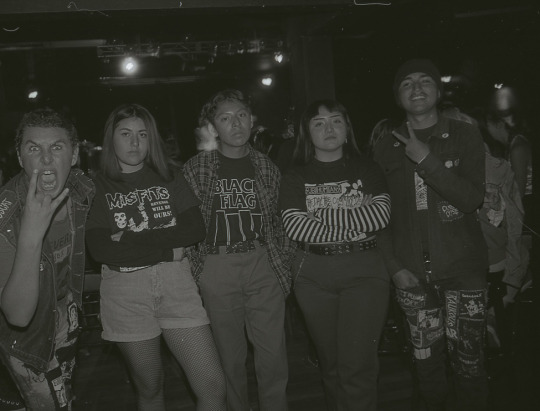
Left to Right: Jagger Age 16, Sydney Mendez Age 16, Rodrigo Hernandez Age 15, Daisy Gonzales Age 16, Andrew Hernandez Age 17 (Shot by Karina Jaramillo)
Sidney Mendez: “My name is Sidney, I'm 16 years old. I live in Placita. I’m Latina and Columbiana. Punk is something that has been a part of my life because it runs in my family. My mom was in a band when she was younger and so she taught me basically everything she knows about punk music. It’s basically something that I’ve been listening to my whole life and never got over it. Punk music is more than just listening and liking how it sounds, it makes me feel alive because of how my adrenaline rises. It’s a contest feeling of happiness for me and it brings me and my friends closer because we share the same interest in music.”

Left to Right: Aurora Zavala Age 20, Karina Perez Age 20, Leslie Mayorga Age 19 (Shot by Karina Jaramillo)
Aurora Zavala: “My name is Aurora Zavala I'm 20 years old I'm latina. The way I dress is inspired by some of my favorite musicians from the '80s and of course, I incorporate my own taste into it. It's important to me because I feel like it represents everything that I like.” Karina Perez: “Well hi my name is Karina Perez I’m 20 years I live in South Central Los Angeles. I’m Latina. Well for me it’s a representation of who I am what I like and it’s important to me because I’m representing the punk scene in some way since we are underrepresented and not really paid attention to an extent. It also represents us female since it’s very dominated by males and shows that females do exist in the punk scene that were out here changing the scene and representing it. And also it is a part of me and my style and who I am as a person.” Leslie Mayorga: “My name is Leslie Mayorga I’m 19 years old and I’m from Los Angeles, I identify as Hispanic. My style varies a lot it’s usually lots of black 80s-esqué garments like dresses, trousers, blazers, etc. I love jewelry too! I’ve made earrings and stuff like that. I feel like the reason I like to dress the way I do has a lot to do with how I express myself and want to physically project myself to others, a lot of times people stare at me and mad dog me and I know the reason for that is because of how I look (dress, hairstyle, makeup) and in a way making people angry or uncomfortable in that sense can be liberating because it’s obvious that if someone feels threatened it’s because they are looking at something they don’t know or even bother to understand/respect and I find it kinda funny and kinda sad how people can be so judgmental. Part of it too is that I just love putting outfits together and adding little details. Fashion and style can be very empowering.”
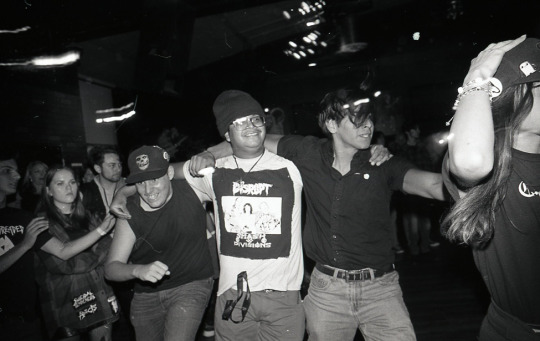
Far Right: Ramon Torres Age 19 (Shot by Karina Jaramillo) Ramon Torres: “Ramon Torres (19) Hispanic. My style is a mix of 90s grunge/punk/hipster style. It’s just a combination of all the things I enjoy listening to or things I find appealing to wear. Usually set myself apart from the general population that wears the new high-end brands while I just thrift most my stuff to save money and mix it up. My style is significant to me because it gives a satisfaction that I don’t look like everyone else and it gives me confidence. This is basically saying to everyone else “This is me, I dress weird and that’s okay.” I always had a sense of style, however, my current style was influenced by OC punk scene going on right now where punk is still seen as abnormal and crazy!”
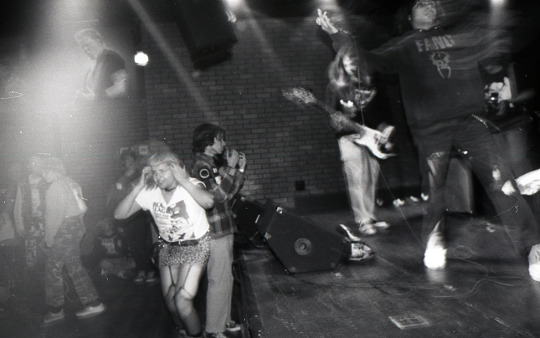
Anai Mata, Age 19 wearing a distress Black Flag Police Story shirt and a cheetah print skirt (Shot by Karina Jaramillo) Anai Mata: “Anai Mata, age 19, born Chula Vista raised Moreno Valley, I am Mexican American, first language Spanish. My style has a lot of rock and roll roots, my dad was a metal head and I would see pictures of him; he'd talk about the music but in very little interest. When of course I was interested. He has the photo of him and his old friend and they're both in heavy leather jackets and hightop Nikes; I thought it looked badass. Anyway, music wise I started off listening to Rage Against the Machine when I was 5 years old and from there I built up a style, you know. My first punk bands were The Adolescents, Conflict, The Casualties, The Clash, and Circle Jerks. I always thought about the punk scene/music was revolutionary. The style itself was fucking everyone off right and it was an outcast thing. That's goes with me. My parents didn't let me dress myself under up to 5th grade and I would dress casual. At the age of 12 through 15, I was making my own shit(jeans, cut shirts and shit like that). I started attending backyard shows at 13 because my brother had this band, so therefore I was exposed to the Moreno valley punk/ska/indie. It was all mixed in from what I remember. Throughout high school I had my docs and patches I shaved my hair into a tri-hawk and would wear it up every day. My dad has beat me up because of the way I would dress and stuff. It wasn't cool but it’s important because it shows the ones that want to see you "normal" or "una pinche niña adolescente" like it’s a big FUCK”
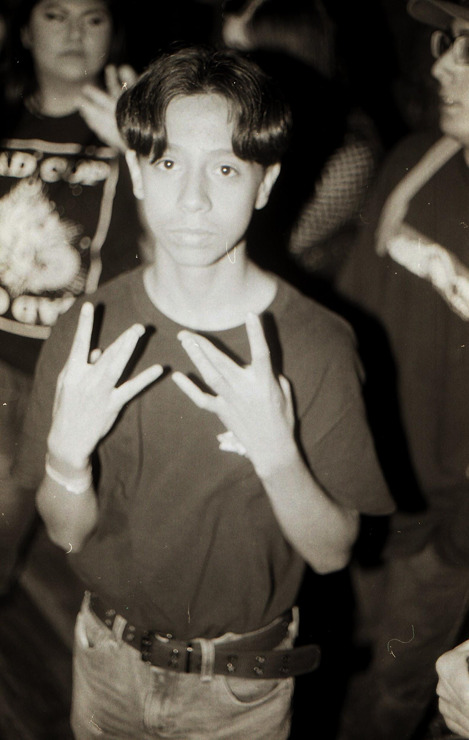
Nathan Salazar Age 15 (Shot by Kelvin Cerezo) Nathan Salazar: “My name is Nathan Salazar. I am 15 years old and I’m from Long Beach, California. I am Hispanic and Guatemalan. My style isn’t exactly the same as everyone else; I like to dress in my own way where I feel comfortable. I like to paint my nails black and wear docs and tuck in my shirt with cut sleeves and wear a bandana around my leg. I paint my nails and wear the bandana because I hate the fashion now and everyone looks the same and it bugs me. I just try to do the opposite like painting my nails to show that I don’t care that “painting your nails is for females. ” The scene is important to me for many reasons. I’m glad punk rock is still thriving because if it weren’t I would be one bored mf but also it gives me a reason just to go out and be with people I can call my friends because we all feel the same about things and how we think people on the outside are. I’m thankful for the scene because how it brings us together in every way not just through feeling but through the love for punk rock and without the scene I don’t even think I’ll have my own band, The Neurotics, and it encourages me and my band just go hard every time we play because we can’t look sorry. I love the people in it yeah everyone’s not perfect but the people I’ve met I’m thankful for that people are really humble.”
#latinx#punk#punk style#latinx punks#punks#la music#los angeles#culture#ucla radio#college radio#other
61 notes
·
View notes
Text
Module 12: Sports
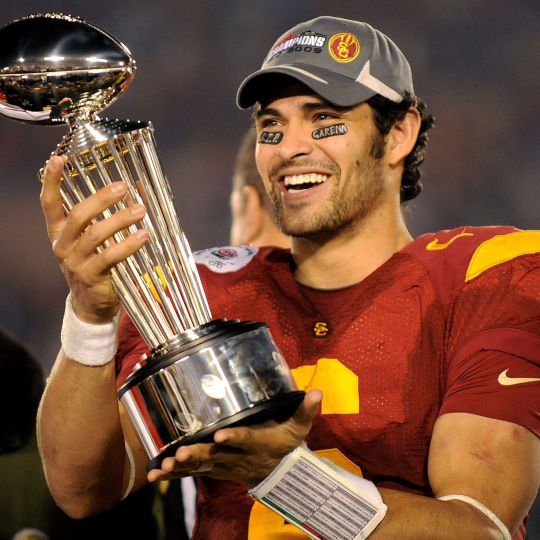
When looking into sports, this chapter highlights how American sports have been exclusive since the early working of organized sports. Where organized sports in America began as a monolithic representation of whiteness that actively tried to exclude minority groups from entering those arenas of competition and athleticism, meaning resources and opportunities were kept from marginalized groups. This created many set-backs for marginalized groups including Latinx athletes where coaches would create teams composed of only all-white players, the cost of sports was highly expensive, and these social stigmas even dominated college admissions affecting the representation of Latinx athletes within professional sports. This led to marginalized groups having to create their own leagues and work twice as hard to get the same opportunities as a white athlete. With this, Latinx athletes were overrepresented in baseball and invisible in every other sport where in reality this is because the baseball league was just trying to accommodate the limited inclusion of nonwhite Others which influenced other sports organizations as well. They were not looked at as true athletes and instead sports just wanted what these athletes were able to contribute to the greater good. There was even objectification and commodification of Latinx bodies in sports were images of athletes on front covers, like Richard Gonzalez, were whitened without any mention of the player’s identity. Eventually, with the women’s liberation movement and the emergence of the NFL it allowed sports to become more visible which allowed Latinx athletes to have an important place within sports. The media also played a major role in the increased engagement of Latina/os in careers in athletics where the ESPN era encouraged Latinx athletes and gave them the representation they deserved. Although, many athletes still faced discrimination and had to fight through prejudices of others while on teams showing the tension created when Latinx athletes achieve high levels of success in American sports. This did not stop Latinx athletes from claiming their spots in American sports, not as outsiders, but as true athletes whom continue to shock the world with their talent and change the meaning behind American sports.
What I found to be of particular interest within this chapter is the success and controversy of Mark Sanchez’s whom was the quarterback for the University of Southern California Trojans. He experienced tons of backlash which erased all his significant achievements due to him having a special mouthguard made that represented the Mexican flag. Where Sanchez showed pride in his culture, identifying as Mexican American, he wanted to acknowledge his family history in which individuals responded by saying, “that young man needed to discard the specialty mouthpiece because many will think that he is a Mexican citizen, and it is an insult to this country, where he was born and raised.” Society ignored all his accomplishments and success because they wanted to shut him down from acknowledging his history and heritage while also representing the Latinx community within Los Angeles. This shocked me, to see how threatened some people are when an athlete whom is other than white has high levels of accomplishments in American sports. Sad to see when white individuals begin to feel out of control, the amount of backlash they will cause on someone.
I can connect this chapter in a way, to my own experiences when I participated in sports throughout high school. Where I only played softball growing up, but I had a realization of how truly expensive sports can be in general. Remembering all the equipment I had to have just to play this one sport and on top of that there were fees to even be able to play the sport, as well as donations the organization would insist on. I would have to help my parent out when it came to trying to afford everything, making me realize the struggle marginalized groups and individuals with lower socioeconomic status had to experience to play.
youtube
0 notes
Text
Judgement (XX)

Astrological Association – Pluto – Planet of transformation.
In card number XX, we see an Angel blowing a trumpet or horn as he looks down on humanity from the heavens above. A flag with a red cross on a white background hangs from the trumpet. Below the Angel, men, women and children rise up from their individual coffins with arms raised in exaltation.
This card represents Judgement Day for one and all. The seeds sown in The High Priestess are now ready for harvest. The Outcome of this Harvest and whether it is welcome or not depends upon what was sewn and where. It also depends on how it was tended and nurtured during the time of its incubation and growth. The harvest referred to in the Judgement card is the final outcome of the sum total of The Fool’s journey through the tarot. The Fool’s Journey is also a metaphor for our journey through life or a particular situation. It is the outcome of all our experiences, beliefs, attitudes and behaviour on our spiritual quest.
The figures depicted in the Judgement Card stand naked, again reminding us that when Judgement Day arrives we will no longer be able to hide behind a facade, lies or pretence. All our deeds, both good and bad will be exposed and laid bare before the Higher Powers and our Higher Self. Nothing can be hidden on Judgement Day.
Those who have studied accounts of the Spirit World will be aware of a body of Higher Souls who we must stand before and account for our actions after each incarnation. These Higher Souls are referred to as The Council of Elders. They are often compared to a judge and jury but this is not the way the Spirit World works or behaves. Once we have passed from the physical and shed our earthly body and brain, we return to our pure Spirit/Soul Form. The Spirit/Soul Form that deliberately chose a certain body type and environment, along with all the challenges this choice would bring.
Spirit’s venture into the physical is to develop and grow by overcoming the challenges of the chosen life. This is how we, in our Spirit Form, evolve. If we have risen to the challenge while retaining our integrity and remaining true to ourselves while helping the rest of humanity along the way, then we have done our job well. However, if we have let the unruly host body chosen for this incarnation overrule our Spirit Self and run amok, letting the ego have first say, then we may possibly have failed. This means that we will have to return once again to learn the Lesson or Lessons which were pre-determined before leaving the Spirit World to incarnate. We will always be given another chance but it may appear more challenging the next time round. There is nothing more discouraging to our form in Spirit State, then to arrive back into the Spirit World after our physical death, only to realise that we have failed in our mission and quite possibly caused distress or hurt to others in the process.
The Council of Elders do not stand in Judgement over each returning Spirit. However, these highly evolved souls do assist the returning Spirit that comes before them to look back on their recently ended life and re-experience the journey from both the Spirit vantage point and those whose lives they impacted and effected throughout their life. This process is referred to as the ‘Life Review’ and is apparently viewed almost movie-like for the returning Spirit to appraise.
Stripped of their ego and recent physical identity, the returning Soul is in a far better position to fully absorb the consequences of all their actions. In Spirit/Soul Form, no blame is every apportioned to another as the Soul accepts full responsiblity for any shortcomings, poor decision-making or lack of judgement. This is because it was the Returning Spirit/Soul itself that had set the various tasks, challenges and environment to incarnate into and not The Council of Elders. The Returning Spirit had planted his own seeds and the Harvest is now his full responsibility too. Therefore, standing before this Council and after the Life Review, the only judgement that can be made is Self Judgement. The Returning Spirit/Soul will be either happy with or disappointed in themselves as a result. It will be the Council who remind them of their good deeds done or their unique strengths and when the time is right, will eventually assist them in the selection a new body and a new environment in which to face their challenges once again. Spirit will be given the chance once again to balance the scales in further incarnations.
The figures of the child, woman and man in the Judgement Card represent the different approaches to life viewed from their individual experiences. They also represent the accumulation our experiences and identities in past lives, for be it in Spirit or Physical Form we are the sum total of our previous experiences. It is by experiencing life through the eyes of a child, woman and man through various incarnations, Spiritual Growth and Evolution occurs..
In the Judgement Card we are being called by the Angel to account for our past or previous actions in life or a particular situation. If we were to be shown our Current Life Review right now, while still in the physical, in all honesty, what would we think? What would we have to say for ourselves? Would we be proud or ashamed? The Judgement Card is all about Karma. We all know that we can attract both good and bad Karma as a result of our actions. Only we can be the judge of which we have attracted the most.
In the journey through the Major Arcana, The Fool encountered many challenges, obstacles and controlling or restricting situations. However, he also encountered opportunities for betterment, freedom, happiness and expansion. It will not be expected that he sailed through life taking all the right turns, making all the right decisions with a big smile on his face. That is perfection and something humans are certainly not capable of.
The challenge from the moment The Fool packed his knapsack and jumped off the cliff was to experience life in its entirety; good times, bad times, grief, happiness, success and failure, gain and loss. The challenge for The Fool was to start out raw but have the desire to understand life from every Elemental Approach as in the Wands (Fire), Cups (Water), Swords(Air) and Pentacles(Earth). He needed to find the balance of each Elemental Approach and blend them appropriately so as to complete the mission he set for himself in the Spirit World. This was the only way The Fool was ever going to successfully make it across the finish line intact and with head held high. The mistakes he made along the way did not mean he had failed. Rather what was important was whether he learned from his mistakes enough so as not to repeat them again. This for all of us is also very important and makes complete sense. The Fool’s Journey was beset with many challenges along the way and it is for certain that he is not the same person he was when he started out on his quest. The question remains as to who The Fool is now and how he turned out? Will he feel confident as he approaches the Council or filled with apprehension and regret? Will he be able to look himself straight in the eye and be pleased with what he sees?
The Judgment Card with the Angel blowing the trumpet heralds the arrival of the time to atone for any misdeeds or upsets caused to others. This could be through the law and courts or the personal desire to right a wrong, to forgive or ask forgiveness of others. In Judgement we realise our connection to all and understand that if we hurt one then we hurt all, even ourself. Judgement can bring an awakening to our True Spiritual Calling and an awareness that we are Spirit first and Physical second. We have found our way home at last, to our True Self and True Life Purpose. All the trappings of the material world are now viewed for what they are, possessions that will at some stage have to be left behind. When we return to the Spirit World it will be as the naked figures below and no one will be able to distinguish the materially wealthy from the impoverished for we will all look the same. Possessions, Power and Status will mean nothing and only Grace will hold any importance when we finally return home.
The Red Cross on the flag represents the arriving at a cross roads in The Fool’s life and the need to exercise clear Judgement as to how he proceeds from here. This crossroads can represent a life changing experience which will transform his beliefs and attitudes and how he perceives himself. The figures rising from the grave have been awakened and are now ready to be reborn into the Spirit World so The Fool at this cross roads has been given the opportunity to completely transform his life which may feel like a rebirth. It is time for him to come to terms with his past and move beyond it for this is where his true vocation awaits him. He must make the right choice as to which direction he takes at the cross roads for the Judgement Card brings Karma with any decision he makes. He can continue straight through the cross roads in the manner which he has been living and thinking or he can take a right or a left which will take him in new directions. He must determine whether he is truly happy to continue on as he is or whether he seeks change and possibly further challenges in search of inner happiness and fulfillment.
The Arrival at this cross roads for The Fool may be welcome or a cause of confusion and frustration. He may feel relieved to be offered a chance to escape the path he has trodden for so long or he may feel threatened by the unknown should he change direction. If he has used his time wisely throughout his Journey in the Major Arcana and fully understood the lessons to be learned in Death, The Devil and The Tower, then he will be in a position to hear his Inner-Voice and understand his True Calling. The Angel’s Trumpet rings loud and clear in his ears and in his Soul and little time will be spent dithering at the cross-roads. The Fool will allow the necessary transformation to occur which is the final stage of his Spiritual and Physical Liberation and Freedom. For the first time in his life, he sees the complete picture of who he is, where he is meant to go and what he has to do. His Judgement is Clear and he can see for miles and miles ahead. He feels uplifted and certain of what he now must do. He realises that he has spent a lot of his life half-asleep or even half-dead. He may not have been living fully in the present at all but now he feels fresh life being blown into his lungs. He has come back from the dead and now knows what it is to feel truly alive.
MEANING
The Judgement Card brings clarity of judgement and positive decisions made. You are now clearly able to view yourself as others see you. It is a time for self-judgement and you must ask whether you are being too easy or too hard on yourself. Remember that none of us are perfect. On the other hand you may feel that others are judging you at present. You may feel under a microscope, with all your movements, words and actions analysed and dissected. This may be unwelcome attention or the result of you entering a competition or possible work/college appraisals or assessments.
The Judgement Card also represents courts, judges and jury so you may be awaiting the final judgment in your case. With the Upright Judgement Card, the Outcome generally works in your favour. However, you must be sure you have told the truth, the whole truth and nothing but the truth as any attempts to lie or deceive will be uncovered. It is a time for owning up and confessing if you have done wrong. You will gain much respect for it and may be given another chance. There may be consequences or a price to pay but you will feel relieved of a heavy burden and your conscience, which has been calling to you, will be cleared.
The Angel’s Trumpet sounds loud and clear and it may bring with it a sudden realisation of how your past has created your present circumstances. This brings a powerful understanding that any actions taken from here on will also impact on your future. Be it welcome or not, good or bad, your harvest is in and there is no denying it. It is a time of maturity and becoming very philosophical about life. A time when you see yourself as part of the Universe and become aware of the bigger picture and not just immediate circumstances.
The Judgement Card suggests that you are heeding the Inner-Call and awakening to your Spiritual Purpose. There is strong clarity now in knowing what you want to do and where you want to go. Judgement brings Humanity Issues to the forefront so therefore, The Angel in Judgement may be calling you to rise up with others who are fighting a worthy cause. Maybe you have the ability to influence others with words. You may be called on to make a speech or to speak out. Others will rally to your cause and your words will reverberate within their souls. You are not alone in your beliefs as there are other like-minded souls in your midst.
The Angel can also represent a musician playing to an appreciative audience or possibly a public speaker.
When Judgement appears in a reading it can suggest that you have reached a cross roads in your life and must exercise clarity of Judgement as to how you are to proceed and which direction to take. If in doubt review your past experiences and actions taken and their outcome to determine which worked out best for you. Which path takes you closer to Spirit and which takes you further away.
Judgement appearing in a reading very often suggests that you may be going through huge transformations at the moment or even re-inventing yourself. Rebirths of all types are possible, even the rebirth of something old or considered long dead. You will feel a strong sense of determination and rejuvenation. These transformations very often happen in mid-life when we suddenly realise that half of our life is already over. We may be shocked to find that so many years have passed doing the same old, same old, day in and day out. We may feel that we never truly found ourselves or if we did were afraid it was inappropriate or the wrong time to run with it. We may feel bored down to our toes and that time is running out on us. It is now or never and every day from here on in must be lived, experienced and meaningful. This may involve major changes and alteration in your life but it will bring liberation and personal fulfilment. Don’t grow old and die before your time. Make a difference with your life and have something to say for yourself and your life when you eventually stand before the Council of Elders. When they ask of you what you did with your life, what shall you say? “Nothing really, I just got by” or worse still “I forget”.
You may be listening to your inner-voice and reviewing your past life. It may be a time to understand the quality and value of what you have in life without constantly needing to add to it. Enjoying the simple things in life can be suggested and this may even involve turning your back on the material world in favour of following a vocation or volunteering to help others.
In relationships The Judgement Card indicates a True Karmic connection. Past life influences may be at play in your relationship, especially if you find your situation particularly challenging. This card highlights the need to proceed with caution of action, thought and deed as this situation may have happened before and is part of your reason for incarnating. Try to work things out for the highest good of all and not for some selfish reason or it may come back to haunt you. If you listen to your inner voice you will find a deep knowledge and understanding that this was meant to be. The gods have conspired to arrange this combination, this relationship, for very good reasons. This relationship will contain a Karmic Lesson to be worked through so be aware of any challenges or obstacles seemingly thrown in its path. Your response to such challenges will be very important along the way for this is no accident. The Judgement Card can also represent a relationship once thought dead brought back to life again as a result of honesty, clear communication and the mutual working through of issues and problems.

1 note
·
View note
Text
What I would like people to know about individuals in the LGBTQ+ Community.

Photo by Ricardo Gomez Angel on Unsplash
This is my opinion and I’m not trying to offend anyone in any way.
So the rainbow flag has been a symbol used by the LGBTQ+ community for years now, since this flag was born it has had some colors removed and some colors added. Obviously every color has a meaning behind it and no, each color doesn’t represent a single sexual orientation or gender identity. Of course everyone has their own view on the flag.
I’m mentioning the flag to talk about the people inside the community, let’s say that each color on the flag indeed represents one particular sexual orientation or gender identity (ex. lesbian=red, gay=blue, trans=yellow, etc.) well in this case we would need so many more colors to represent every single category because boy there are so many of them!
So continuing on with the last supposition this is what I want everyone to understand about people in the community: “Blue might be the color for people that are gay, but that blue should represent every single shade of blue that exists” and why do I point this out, well because a lot of people still have the misconception that all gay men are the same, (same for lesbians, bi, trans, etc.) we are not the same! We are all individuals born and raised into different families, went through so many different situations, have different thoughts, different political views, different tastes in food, different hobbies; all of these things combined made each one of us different. So, we might be all be gay but we all represent a different shade of blue. And all lesbians are represented by Red but they’re all a different shade of Red... Don’t put us into a stereotype, don’t judge us without getting to know us first. Some gays like to play with dolls and some others with soldiers, some like to dance and others like to play soccer, I for an instance don’t like any of those last two sports because I’d rather play baseball. There is nothing wrong with playing with soldiers or dolls or both and also being part of this community, those things do not define us in any way. Being lesbian, gay, bi, trans, queer, pansexual, asexual, straight, etc. is just one trait of ours but it’s not everything. So I might be Blue, but I am MY OWN shade of blue.
Go ahead and share your opinions.
S.
#gay#gay love#bisexual#bi#catholic gay#catholic bi#catholic bisexual#catholic lesbian#lesbian#lesbian love#queer#trans#rainbow#love is love#we are all human#we are all equal#i also like guys#love#men#women#non binary#share the love#rainbow flag#christian gay#christian bi#christian lesbian#lgbt#lgbtq#lgbtq+#christian lgbtq
7 notes
·
View notes
Link
This is how we can envision Black freedom
For the U.S. to untangle itself from its legacy of white supremacism, we must live like we understand what our true history teaches us, from Emmett Till to George Floyd.
PUBLISHED MAY 25, 2021• 20 MIN READ
I.
On June 27, 2015, Black artist and activist Bree Newsome Bass climbed the flagpole at the South Carolina statehouse and took down the Confederate flag that had flown above the people of that state for over 50 years. This act came 10 days after a white supremacist murdered eight Black parishioners and their pastor at Emanuel African Methodist Episcopal Church in Charleston. Grown from a congregation first organized by enslaved and free Blacks in the late 18th century, Emanuel is the oldest African Methodist Episcopal church in the American South. It is a church where Black freedom has been envisioned and practiced throughout the entirety of its existence, from the 19th-century congregant Denmark Vesey—who bought his own freedom and helped plan a revolt of his fellow human beings who were still enslaved—to the 20th-century civil rights marchers and leaders who regularly gathered within its sacred space.
As she expected, Newsome Bass was arrested as soon as she rappelled down the statehouse flagpole, Confederate flag in hand. Her act memorialized Emanuel’s pastor and parishioners. It also made an ephemeral but indelible monument to Black freedom.
When asked why she did what she did, Newsome Bass answered, “I did it because I am free.”
What does it mean to be Black and free in a country that rejects Black freedom?
II.
I am an educator who teaches students about submerged histories, revelatory art, and the critical thinking that sharpens questions that move us toward truth. I am a poet, and my poet’s tool is the word. The word is holy and bears the heft of human experience; the poet must wield it as precisely as possible. I have found that writing poems brings me closer to understanding my fellow human beings—individually and in community—in our many contradictions and complex histories. Poems give form to truths and understandings that might otherwise be lost.
As leader of the Andrew W. Mellon Foundation, I am privileged to help support artists, thinkers, researchers, and other kinds of builders who illuminate stories and experiences that have often been hidden, overwritten, or mistold.
In a year darkened by loss, their light shone with particular power through the work we are supporting with the largest initiative in our history, the Monuments Project.
We have found inspiration in monuments like artist Judith Baca’s “Great Wall of Los Angeles,” a vibrant mural more than half a mile long that has brought together dozens of community members over 40 years to paint a richer, more inclusive history of California.
We supported a new memorial to Emmett Till, the 14-year-old Black boy from Chicago who, when visiting family in Mississippi in the summer of 1955, was kidnapped, tortured, and murdered by two white men for allegedly whistling at a white woman. His mother brought his body back to Chicago for an open-casket funeral to “let the people see what they did to my boy,” and Jet magazine published photographs that would widely spread the word of a terrifying story that was not isolated.
Till became an emblem of the racist violence that Blacks were still subject to and helped to catalyze the civil rights movement. The site sign that marks where his body was pulled from the Tallahatchie River in Mississippi had to be replaced many times because it was riddled with bullet holes.
As an educator and fieldbuilder in African American studies, I believe that the knowledge from this field sits at the center of any genuine understanding of the United States, holding the legacy and ongoing existence of anti-Black enmity in its unflinching gaze alongside the knowledge, philosophy, and creativity that emerges from this American history of struggle and endurance.
The lynching of Emmett Till and the mass murder of the Emanuel parishioners—among countless other acts of anti-Black terrorism down through the generations—underscore this truth about our country: It was built in part, and is still being built, on anti-Black hatred and violence. How do we move forward with this contemptible knowledge and its antidotes as our guides?
III.
On January 6, 2021, domestic terrorists carried out a violent insurrection at the United States Capitol. Incited by the president and some in the U.S. Senate and House of Representatives, this armed and organized mob brutalized law enforcement; killed a police officer; terrorized democratically elected representatives, their staffs, and some of their family members; assaulted journalists; erected a gallows; looted offices; stole documents and laptops, including that of the speaker of the House, which the thief allegedly planned to sell to Russian agents; smeared human feces through the building; and extensively defaced commemorative displays and works of art, including a memorial placard to Congressman John Lewis, the recently deceased civil rights icon.
Also on that day: A Confederate flag, which had never before breached the heart of Congress, was waved in its halls by one of the terrorists. This flag memorializes white supremacy, commemorates the lost cause of those who fought a war to keep Black Americans enslaved, and instructs race-based hatred.
After hours spreading savagery and chaos through the halls, the terrorists were largely allowed to depart the Capitol unfettered. Photographs showed Black and brown custodial workers cleaning up the wreckage the mob left behind.
IV.
Years ago, I wrote a series of sonnets in the voices of young Black women who studied at Quaker educator Prudence Crandall’s school in Canterbury, Connecticut, in the 1830s. White parents pulled their daughters from the school because they did not want them educated alongside Black students, but Miss Crandall continued educating those young Black women and girls despite the violent opposition of Canterbury’s white residents. Those residents ultimately burned the school to the ground. Miss Crandall’s unwavering courage could not keep the schoolhouse safe. But in the sonnets’ vision, the rare quest for education for Black women was “the one perfect religion” that the townspeople could not destroy.
Without learning, without knowledge, without the voices and the experiences and the insights gained from a determined excavation of our country’s past, we will never eradicate racism and racial violence. If we are to stop weaving white supremacism into the fabric of our country, then we must learn our full histories. We must live like we understand what that history teaches us.
In a poem, I once portrayed the great poet Robert Hayden in the 1940s as he dedicated himself, “stoop-shouldered,” to sifting through the records of the slave ship Amistad, extracting history’s hidden insights and the story of resistance from that ship’s log. “Blood from a turnip,” I wrote of his daunting and exhausting process of deep research to tell the story of “this / protagonist-less / Middle Passage” from the perspective of the captives rather than solely that of the captors.
Ultimately the “slavers’ meticulous records” revealed the determination of the Africans on board to resist being dehumanized as property. That gave Hayden, in turn, the knowledge he needed to tell us the story too few had contemplated: that there were many Black people who challenged slavery as their fate and fought back for their freedom, as well as white people who were their allies.
To return to Miss Crandall: After her school was destroyed, in 1834, one of her students, a young Black woman named Julia Williams, moved to New Hampshire to study at an integrated school. There, as in Canterbury, the act of teaching Black and white children together drew a violent response from white people in the community. I researched the history and then described, in the conjured voice of Miss Williams, an unforgettable true scene:
From the town and neighbors came three hundred armed men, ninety oxen teams.
They dragged the school building utterly off its foundation. I have twice seen bloodlust and ignorance combust. I have seen it.
Bloodlust and ignorance combust. I continue to return to those words.
V.
New York City, where I was born, is a city that exists in the mind and in the matter-of-fact corporeality of day-to-day New Yorkers as one definition of freedom—freedom of expression, freedom of belief, and the power of a multicultural metropolis.
The identity emerges from complexity. More enslaved Black people lived in New York City in the 1700s than in any city other than Charleston, South Carolina. Many free Black people lived in New York as well, in places such as Seneca Village, where residents were forced out by eminent domain in 1857 before the community was razed to build Central Park. Those enslaved and free Black people’s stories still speak to us through material clues such as the coins, beads, coffins, and shrouds left behind in subterranean sites like the African Burial Ground in Lower Manhattan.
In Brooklyn, in 2001, five corncobs laid out in a distinct shape were found in a crawl space of a house. Those corncobs formed a star, scholars determined, that suggested a West African cosmogram, one that conveys two worlds of the living and the dead, both eternally connected in a West African vision of the cosmos in diaspora.
When I read about that archaeological discovery, I envisioned the moment when the rumor of freedom was made real, in a poem called “Emancipation”:
Corncob constellation, oyster shell, drawstring pouch, dry bones.
Gris gris in the rafters. Hoodoo in the sleeping nook. Mojo in Linda Brent’s crawlspace.
Nineteenth century corncob cosmogram set on the dirt floor, beneath the slant roof, left intact the afternoon that someone came and told those slaves,
‘We’re free.’
Imagine, the revelation of freedom—two words, “We’re free.” We are still enacting and imagining the aftermath.
VI.
In mid-century Los Angeles, in the Watts neighborhood, an Italian immigrant named Simon Rodia built an extraordinary structure by hand. The Watts Towers soar toward the sky in multiple forms, nearly a hundred feet tall at the highest. Rodia envisioned and built the towers day by day over three decades, from durable steel and delicate wire mesh, bottle glass, white seashells, pottery shards, mint chip and maraschino mosaic tiles, shades of lapis lazuli, cobalt, and the thick, bright yellow of a crayoned sun. Like the “corncob constellation” left behind in the crawl space of the house in Brooklyn, each seemingly mysterious object carries power and meaning.
“It shows that we are people too, that we have brains and we can make it too if we put our minds to it,” Carolyn Byers, a young woman from Watts, said of the towers. She was talking to a reporter in 1991, the year Rodia’s vision was designated a national landmark; six months before that, a Black man named Rodney King was brutally beaten by white police officers in the San Fernando Valley, and the officers’ subsequent acquittal sparked five days of riots across South Los Angeles.
Rodia moved to Watts about a century and a half after the Spanish founded the pueblo that became Los Angeles. Many of the Gabrielino-Tongva peoples who were the first inhabitants of the Los Angeles Basin were forced into enslaved labor at the region’s Spanish missions. By 1848 the part of Tovaangar that would become Watts had passed from the Spanish Empire to the Republic of Mexico and then was taken, along with more than half of Mexico’s territory, by the aggressively expansionist United States at the conclusion of the Mexican-American War.
Rodia lived in the community as it changed from one populated mostly by whites and Mexican Americans to a home for African Americans who had left the South in the Great Migration. By the time he completed the towers in 1954, the Watts community was predominantly Black; today, one full century after he first put his hands to steel at East 107th Street, it is majority Latinx, including large communities of Mexicans and Salvadorans. Throughout this time—throughout Los Angeles—descendants of the Gabrielino-Tongva peoples have continued to live in and honor their ancestral homeland. None of these complexities contradict; we must understand them together.
I have always been so moved by the inspirational power and seeming impossibility of the towers that I described them in the poem “Stravinsky in L.A.”: “The Watts Towers aim to split / the sky into chroma, spires tiled with rubble / nothing less than aspiration.”
To aspire: from the root meaning, fundamentally, “to breathe.”
VII.
When my family moved to Washington, D.C., from Harlem in late 1963, many parts of the city were racially segregated. I grew up a few blocks from the U.S. Capitol. My family and I would regularly stroll its meticulously tended grounds and sometimes picnic. Most years on the Fourth of July, we’d lay out blankets in the humid evening and listen to the U.S. Marine Band as fireworks exploded overhead in the summer deep darkness.
The Library of Congress was my childhood library because the Library of Congress is a public library. In high school I would research and write my papers there. Sitting in the glorious rotunda, I would think with excitement how the very building in which I learned held almost every single book on Earth. Anyone who walked through the doors had access to them.
I knew that the Capitol was where the actual business of our country’s governance took place and that it stood gleaming as both a symbol and a site for working out the complexities of millions of different people, with all their beliefs and backgrounds and experiences, living alongside one another in an ever evolving democratic experiment. My parents taught me that the Capitol was built by enslaved Black people, and that reverence for a space that was ours did not erase understanding voter suppression and the three-fifths compromise. They showed me how to hold seeming contradiction with a comprehension of our full history.
At the Lincoln Memorial, the towering marble form of the 16th president might make a child feel dwarfed, just as it made me feel as a child. But I want the child of today to understand that this figure is not merely a shadowing stone statue. It is also a site of powerful community gathering and activation. As the central location of the 1963 March on Washington and Martin Luther King, Jr.’s “I Have a Dream” speech—and so many marches to follow—the Lincoln Memorial is one of the most significant sites of civic action in our history. When Marian Anderson sang “my country, ’tis of thee” on its steps in 1939, she rebuked the segregation that had barred her from singing in Constitution Hall before the Daughters of the American Revolution.
Monuments and memorials are places where people come together to remember, to collectively mark a moment, to be a “we,” to help identify a new direction, and to make a way forward. This is the case even when the way forward is shaped by grief and not by joyful determination. The Vietnam Veterans Memorial, designed by the artist and architect Maya Lin when she was just 21 years old, introduced into the D.C. of my young adulthood a memorial that had no precedent in the D.C. of my childhood. This slash into the earth bears no figuration. It holds instead the ephemeral reflections of those who walk down into the ground to mourn their dead, evoking the true cost of all wars. It does so even as it raises unarticulated questions about the millions of Southeast Asian people who also were killed in that particular war, and whose names are not recorded on the memorial’s black granite.
What would it mean for us to have monuments and memorials that do not teach us to memorialize war or to commemorate fighting against others? What would it mean to enact the enduring spiritual’s words, “I ain’t gonna study war no more,” in our monuments?
VIII.
Tell the whole damn truth, in our history, our art, our words, and our memorials.
Mighty civil rights and voting rights activist Fannie Lou Hamer’s words are the simple truth: “Nobody’s free until everybody’s free.” Fighting for Black freedom means, in the words of Robert Hayden, “visioning a world where none is lonely, none hunted, alien.” It means understanding 19th-century Black enslavement alongside 21st-century Black mass incarceration; comprehending why Emmett Till’s casket is the most sacred object in the National Museum of African American History and Culture; acknowledging the horror of George Floyd’s and Breonna Taylor’s murders standing in seemingly never ending seriality with so many other murders. Fighting for Black freedom means centering the crucial questions raised by decades and decades of African American studies; they are still the right questions. And recognizing that the bravery of Bree Newsome Bass in June 2015 is more powerful than the violent desecration of the U.S. Capitol in January 2021.
Most days I play or hear in my head Nina Simone’s 1967 version of the Billy Taylor song, “I Wish I Knew How It Would Feel to Be Free.” The song has light and delight; it is singable, and in one facet, joyful. But the “wish” is both a commanding action—wish it, make it happen—as well as a word that says we’re not there yet. The conditional tense, “would,” marks that freedom is not fully attained.
The song’s bright music moves us ever forward. But Simone’s voice, in all its coloration and nuance, the dark side it carries in its light, reminds us that freedom—the right of every one of us—is a process. Freedom is work. Freedom doesn’t come by wishing. We must vision it. And we have survived by enacting those visions.
Elizabeth Alexander—poet, educator, memoirist, scholar, and cultural advocate—is president of the Andrew W. Mellon Foundation. She is the author or editor of 14 books and twice was nominated for a Pulitzer Prize; her book The Trayvon Generation is to be published this fall. She wrote the poem “Praise Song for the Day” for Barack Obama’s presidential inauguration in 2009 and delivered it there.
This story appears in the June 2021 issue of National Geographic magazine.
0 notes
Text
Art Director week
This week we were tasked to be art directors. we were paired up and one had to choose an article for the other and vice versa.
Illustrator’s POV
I was partnered with my friend Amara, and she gave me an article to create an editorial illustration for from The New Yorker Magazine titled “ Returning to Storm King”
The text went as follows:
“Few installations at the Hudson Valley sculpture park are new, but in this pandemic summer the park’s breeze, changing light, and theatre of clouds are novelty enough.
What’s with the metal-band-worthy name of Storm King, the marvellous sculpture park—or, better, landscape with sculptures in it—about fifty miles north of Manhattan, in Cornwall, New York? I’ve just spent some happy hours there, sprung from months of art deprivation, on the occasion of the Storm King Art Center’s reopening to visitors with timed tickets. The setting is thundery enough, under the mighty brow of one of the highest mountains of the Hudson Highlands, in a valley of variegated hills, lawns, meadows, forest, and waters, along with elegant alterations that include arboreal allées and plantings with deference to native flora—some five hundred acres hosting roughly a hundred art works. I hadn’t known, until I was told during my visit, that the park’s name owes its provenance to the Romantic exasperation of a writer who, in 1853, pressed locals to rebrand their principal mountain Storm King from—get ready—Butter Hill. That nineteenth-century embrace of the hyperbolic anticipated the moxie, in 1960, of two art-loving businessmen, Ralph E. Ogden and his son-in-law H. Peter Stern, who gradually acquired much of the valley. They founded the park as a nonprofit entity, made a museum of an existing château on a hilltop, and pondered the ambient possibilities of the terrain.
In 1967, Ogden bought thirteen works from the estate of America’s greatest sculptor, David Smith. Mostly made of welded steel, they deploy a repertoire of shapes, from the surreally animate to the nobly abstract, gracing dancerly postures with lyrical drawings in space. A suite of eight of them, currently installed under cathedralesque oak and black-walnut trees, is modestly scaled. Not so the vista-dominating, gestural arrays of mostly steel elements by a favorite of the collectors since 1968, Mark di Suvero, which at times suggest playground facilities for giants. Nine of those were supplemented last year by a three-year loan of “E=mc²” (1996-97)—a tower, more than ninety-two feet high, whose converging I-beam legs are topped by flaring forms in stainless steel that grab at the sky. Also monumental are two maximum-sized stabiles by art’s foremost bejeweller of air, indoors or out, Alexander Calder. There are major works, as well, by Richard Serra, Andy Goldsworthy, and, most recently, Maya Lin, whose earthwork “Storm King Wavefield” (2007-08) represents a vast expanse of mid-ocean waves, up to fifteen feet high, with grassy undulations.
Sculpture parks proliferated, worldwide, in the second half of the twentieth century, in the wake of an identity crisis for large three-dimensional art. Modernist austerity had stripped sculpture of its traditional architectural and civic functions: there were no more integrated niches and pedestals, few new formal gardens, and an epochal apathy regarding statues—until lately! (We are now practically neo-Victorian in our awakenings—rude, for the most part—to symbolism in statuary.) Never mind the odd plaza-plunked, vaguely humanist Henry Moore. Where could one put outsized works that were almost invariably abstract—modernism’s universalist ideals persisting—to give them a chance of seeming to mean something? In nature! Conjoining the made with the unmade, gratifying both. Sculpture parks emerged as game preserves and laboratories for big art. Storm King’s early concentration of works by relevant artists of the late nineteen-sixties and seventies includes some formulaic banalities, tending to presume a surefire magic in embowered angular geometry, but even there you may savor the zest of a moment when sculpture jumped into nature’s lap. The history is complicated and obscured, in the art world, by the contemporaneous development, in the sixties, of Minimalism, which, by engaging the physical presence of viewers, shrugs off its surroundings. (The park’s chastely white modular piece by Sol LeWitt doesn’t mind a bucolic site one way or another.) As a consequence, Minimalism sidelined poetic potencies that prove their lasting worth at Storm King.
Prior visitors won’t be kept away by learning that few installations in this pandemic summer are new. The park’s changing light, breezes, and theatre of clouds will do for novelty. The best recent addition, on view until November 9th, is “River Light” (2019), a ring of nine high-flying cyan-blue silk flags that Kiki Smith derived from a sun-sparkled film she made on a walk along the East River. Wind stirs the fabric to rippling, soft applause. The ensemble suggests a rallying point for angels. Also new is “A stone that thinks of Enceladus” (2020), a piece by a young New York-based artist, Martha Tuttle, which consists of a mowed field studded with boulders and cairns and rather hectically festooned with carved rocks and molded glass stones. Close by, propped on an island in a pond, is a startling curio, the hull of an America’s Cup-grade racing boat that, in 1994, was prettily decorated with a mermaid motif by Roy Lichtenstein. Its abrupt presence, which you may less look at than gawk at, invokes the metaphysical truth that everything has to be somewhere. Storm King’s prevalent rectitude might serve as a foil for other sorts of interesting shocks, within appropriate limits.”
The images needed to be 1980 x 2560 pixels and my art director wanted me to capture the hudson valley landscape in the image.
I did some research of the sculpture park and sent my roughs in:



The third image was approved.
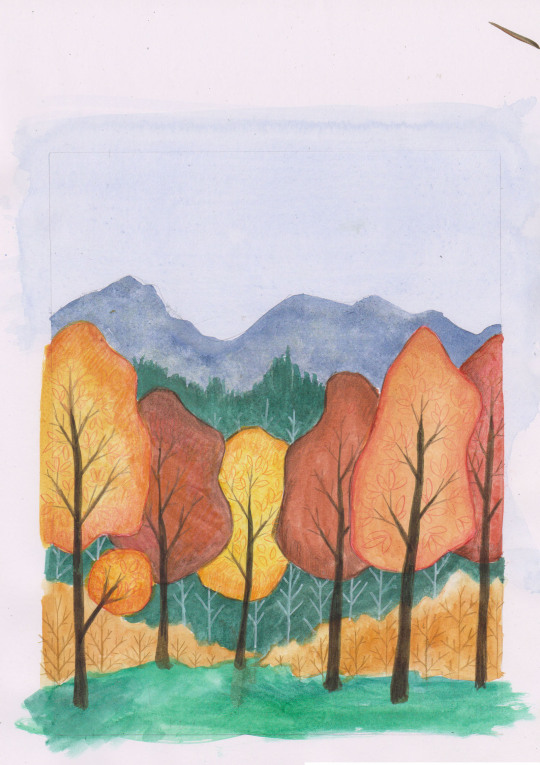
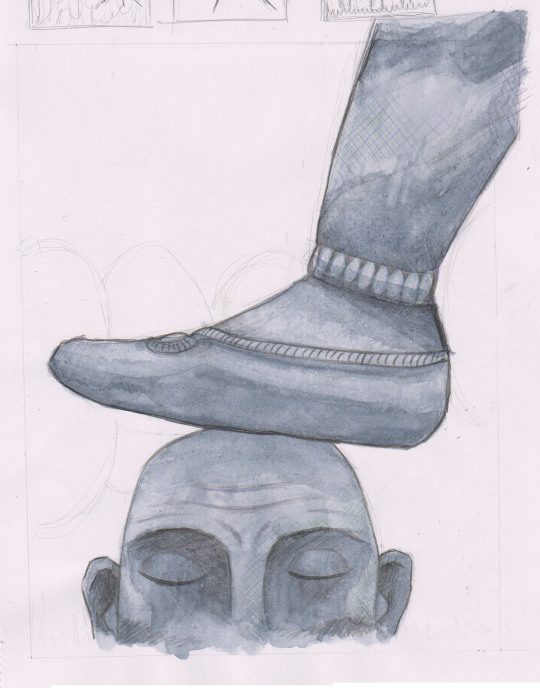
I tried a new technique with this piece that I have been meaning to try for a while. I used Watercolour and coloured pencils to introduce some textures in my work and I drew the background and foreground seperately so that the image could have a collage-inspired feel to it. The collage style didn’t end up as I was hoping but I think that what it ended up looking like was just as interesting.
I then used photoshop to merge them together (which was a lot more of a hassel than I was expecting as the drawings were bigger than my scanner at home so I had to scan the images in parts and photomerge them together on photoshop). I also added some extra details digitally (the clouds, leaves and ground) to create this final piece:

The art director was very happy with the image and had no major changes.
I was also incredibly happy with this piece. The new medium really worked for me and I really feel as though this piece could be a turning point in my artwork.
Art Directors POV
I found a good article on Country Living magazine that I thought Amara would enjoy illustrating, as I know from her previous work that she enjoys drawing people and animals. For this task I pretended to be an art director for Country Living magazine in an attempt to make my emails as realistic as possible.
The first email was as follows.
Hello,
I am an art dierctor for Country living Magazine, I came across your work and I would like you to create an illustration to accompany an upcoming article for our magazine.
The image would need to be full colour and 1280x720 pixels at 300 dpi
The article is as follows:
Country Living Magazine
Dogs are our oldest and closest companions, new DNA has confirmed
Pups were domesticated before any other known species
We know that dogs are man's best friend, but new DNA has confirmed that they are in fact our oldest and closest companions, too.
The study, which was conducted at London's Crick Institute, found that dogs were domesticated before any other known species. Interestingly, it discovered that humans have had pet dogs for around 11,000 years, showing just how far back our love for them really goes.
Shining light on the "inextricable bond between dogs and humans", the study is based on DNA from 27 ancient canine specimens from around Europe, Siberia and the Near East.
"Dogs are our oldest and closest animal partner. Using DNA from ancient dogs is showing us just how far back our shared history goes and will ultimately help us understand when and where this deep relationship began," Greger Larson, a co-author from the University of Oxford, told BBC News.
Elsewhere in the research, they also found that the genetic patterns of dogs were fairly similar to that of humans. This is because when humans adopted dogs, they took them with them wherever they moved and shifted, strengthening their bond.
Anders Bergström, lead author and post-doctoral researcher at the Crick, also added: "If we look back more than four or five thousand years ago, we can see that Europe was a very diverse place when it came to dogs. Although the European dogs we see today come in such an extraordinary array of shapes and forms, genetically they derive from only a very narrow subset of the diversity that used to exist."
Just another reason to adopt one of your own...
Many thanks,
Hannah Jones
Art director for Country Living Magazine.
The same day, I heard back from her with attatched roughs.
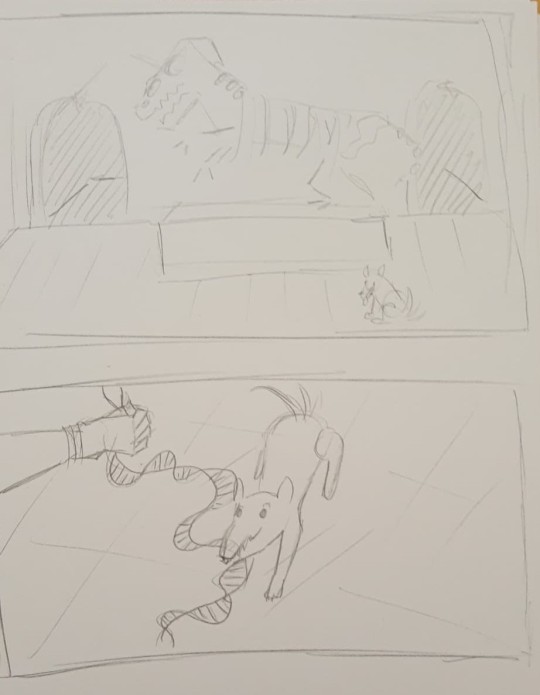
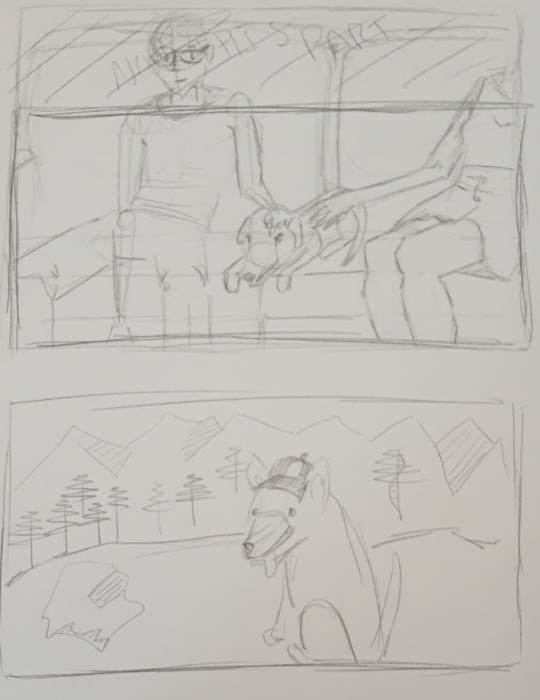
I liked the second one best as the concept was clever and the composition was very nice.
After a short while she came back with two different options of the image.
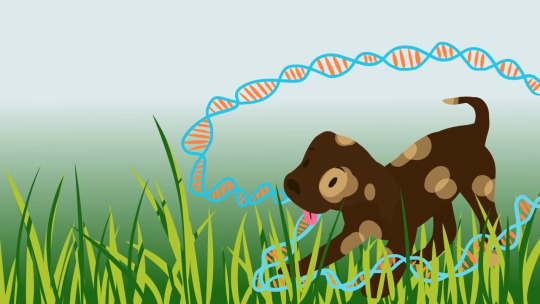
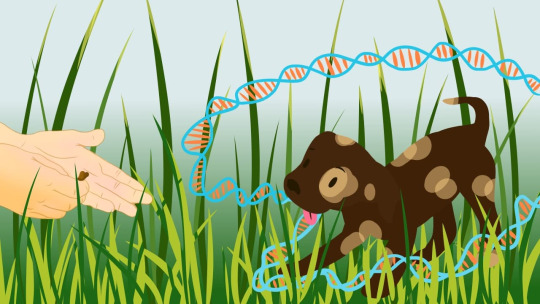
One without hands and one with hands, I prefered the image with hands as it showed the human connection with dogs more, which is what the article is all about.
Overall, I was happy with the finished image so I approved it. I think she did a really good job.
You can follow Amara’s fantastic work at https://www.instagram.com/apiple_art/
1 note
·
View note
Text
Someone actually asked me a question that didn't take me 2 lines to answer LD So yesterday, after giving a friend a brief explanation of where I sat generally in the LGBTQness of things, and why i posted 'gay pics' when i'm ace. I said I'd answer any question people wanted to ask, within reason and then a little later I was asked if i could "explain your nonbinaryness a bit?" Now. I've been considering it..but then, I've been considering the label itself for a while. I don't want to make a deal of it..my definition may not fit with the way other see the term. but I said I'd try I'm always ify on whether i should openly class myself as Non-Binary its a grey area for me. but it fits as well as being an Aromantic Asexual does.. however, now I've said it a few times, it fits more, especially as, its a fluid term with different sides to the meaning. A friend of mine came out as Non-Binary if only in their own mind recently, i'm not sure who they've told and not so i'm not saying anything, its thanks to them I even know there is a flag. The only reason i'm bringing this up is I want to stress here. that I am not copying, you mate, i promise. people always think i'm copying for attention (and they know who they bloody well are) but i swear on the Angel this is not attention seeking or copying or anything like that. this is me just saying there is another shade of grey to my.. i'd say blob but the weight correlations there make it the wrong term. you get what i mean anyway. but i'm going off on a tangent and i'm supposed to be explaining Non-Binary right, so.. I thought and this may be cheating but I think..as a description for me, Sam Smith's definition of Non-Binary works best, in an interview they was asked to describe it and said it was a “mixture of all different things”, like them I've never really identified in my own head as as “male or female”, non-binary can mean different things to different people. in brief...well Stonewall UK – a charity that campaigns for the equality of lesbian, gay, bi and trans people across Britain – Non-Binary is described as an “umbrella term for people whose gender identity doesn’t sit comfortably with ‘man’ or ‘woman’". A little more detailed:people whose gender is not male or female use many different terms to describe themselves, with non-binary being one of the most common. Other terms include genderqueer, agender, bigender, and more. None of these terms mean exactly the same thing – but all speak to an experience of gender that is not simply male or female. Some societies – like ours – tend to recognize just two genders, male and female. The idea that there are only two genders is sometimes called a “gender binary,” because binary means “having two parts” (male and female). Therefore, “non-binary” is one term people use to describe genders that don’t fall into one of these two categories, male or female. Non-binary people are nothing new. Non-binary people aren’t confused about their gender identity or following a new fad – non-binary identities have been recognized for millennia by cultures and societies around the world. Generally... try not to make any assumptions about people’s gender. You can’t tell if someone is non-binary simply by looking at them, just like how you can’t tell if someone is transgender just by how they look. A little something on the flag i mentioned before. for people who identify as some form of Non-Binary is Yellow, White, Purple and black. *Yellow represents people whose gender exists outside the binary, *White represents those who embrace many or all genders * Purple represents those who feel their gender is a mixture of – or between – male and female, *And black represents people who feel as if they have no gender, This random attempt is more likely to make people more confused regarding myself. but I hope its cleared up something about Non Binary in general.

0 notes